The Campanile
In this year’s midterm elections, some students like senior Yash Shetty voted for the rst time.
“I think I’ve grown up my entire life hearing my parents discuss dif ferent propositions in primary elec tions or in general elections, and it’s very surreal to nally be on the other side and for my voice to count,” Shetty said.
Shetty said while many young people think their vote won’t count, teens should vote because a large number of people can a ect an elec tion.
“Obviously, my vote isn't going to be the swing vote in any election,” Shetty said. “But I do think that it’s important that young people do vote, because if every person has the mindset that ‘Oh, my vote doesn't count,’ then that accumulates and then eventually you reach a number that would have counted.”
Senior Bella Daly said she found ways to be involved in politics before being old enough to vote for the rst time in this election.
“I have a postcard writing club (Postcards for Change), so that’s one way I’ve gotten involved with politics without being able to vote,” Daly said.
Working with the nonpartisan organization Reclaim Our Vote, Daly and her club sent postcards to historically underrepresented voters with information on how and where to vote, but not who to vote for.

While her club presents her with an opportunity to engage citizens across the country, Daly said voting this year feels particularly signi cant.
“Now that I can vote, I actu ally feel like you have a say in who’s controlling you and the propositions, and what’s going on around you in your city and your state,” Daly said.
Senior Morgan Greenlaw also voted for the rst time this year.
Greenlaw said she encourages students to vote to meaningfully contribute to their communities.
“Everybody should vote because you get to, and the decisions that are made are supposed to re ect the opinions of the people,” Greenlaw said. “So if you want your opinion heard, then you should voice it.”
Margot Blanco Editor-in-Chief
Introduction to Analysis & Calculus teachers announced the administrative decision to collapse a fourth period IAC class and replace it with a precalculus class to make more room for existing precalculus students on Oct. 17.
After the teachers announced the decision, 16 students in the fourth period IAC class were trans ferred into di erent IAC periods. IAC teacher Zachary Barnes said the precalculus classes became too large and students couldn’t receive proper attention as a result.
“In order to be successful, the student to teacher ratio is vital,” Barnes said. “For the precalc classes in particular, it had gotten to a point where the teachers could not be e ective with all the students.”
Administrators declined to com ment. Barnes said some students were understandably upset over the sudden change, especially since it took place well into the school year.
“Any change in classes is disrup tive,” Barnes said. “ is is telling 16 people that their schedules are going to be changed.”
Junior Felicia Bulchhoz said the unexpected schedule change pre vented her from downlaning in the IAC class she was struggling in. e only period I could drop into would be into a class which I cannot switch,” Bulchhoz said. “So, I am stuck in the lane I am cur rently in, and they’re forcing me to not drop.”
Guidance counselors declined to comment. Junior Kaitlyn Abassi said she felt the relationships she built with her teachers became cut short, even though her schedule did not signi cantly change.
“For one of my classes that got changed, I was hoping to get a letter of recommendation from the teacher,” Abassi said. “But then the teacher changed, so I couldn’t do that anymore.”
Barnes said he trusts that the kids in his class will succeed despite the disruptions in their schedules.
“ at fourth period class is an amazing group of kids,” Barnes said. “We all want to do what’s best for them and make that a continu ous path of success.”
Art programs lack funding as student enrollment climbs
As enrollment in glassblowing and ceramics classes has risen from around 70 students to 90 students, funding from the state and district for these classes has remained at.
Ceramics teacher Steven Ferrera said he has had to rely more on volunteer help, encourage students to save their materials and have stu dents do fewer projects. Ferrera said part of the issue his classes face this year is that consum ables, such as clay and glaze, have skyrocketed in price due to the pandemic and in ation.
“Most of the stu we use are raw materials that are now harder to get,” Ferrera said. “It makes it more di cult to do a lot of the cooler advanced stu .”
Ferrera said the state of California gives him about $40 per student for the entire year, along with nancial support from the school in the form of block grants.

Block grants are grants given from the federal government to the state and local governments which can then decide where to use the money. is money is used to directly purchase materials.
“( e funding) is never enough,” Ferrera said. “If you look at it just in terms of clay for the entire year, each student would get four bags of clay and one pint of glaze. My Advanced (Ceramics) kids could go through that in the rst quarter.”
Ferrera also said he mostly relies on glass sales and workshops to fundraise, including the Fiery Arts program where people pay to create glass pieces with glassblowing instructors.
Jeremy Rosenbaum, a Fiery Arts instructor, said instructional hours are often the rst cuts to happen in elective programs.
“( e Fiery Arts program) has to use their funding for both instructional hours and for production and for supplies,” Rosenbaum said. “And the production for the glass sale creates funding for everything else.”
To compensate for the lack of funding, Ferrera said he has altered his lesson plans and encouraged students to save materials. Now, projects are less complicated and don’t require as many resources.
However, junior Ash Batory said the amount of funding has de nitely a ected the number of projects they would have liked to do. e most recent project, bead making, was canceled due to lack of materials.
ere was no way to replace it without the funds,” Batory said. “We were going to make glass beads, but we need oxygen tanks for that, and it’s around $200 for an oxygen tank.”


Batory said their class is making their next project out of paper instead of other supplies like clay. e paper project, initially planned for later in the year, was moved up so Ferrera
could gure out how to make due with the lack of materials.
“ is is not what I signed up for,” Batory said. “It’s de nitely not the teacher’s fault — he’s doing his best. It’s just the lack of funding.”
Batory said the glass studio manager, Chris Lewellyn, still visits in his free time to help with glassblowing but he’s not getting paid anymore. Also, they said while students are still allowed to blow glass, they are left on their own, and it’s really di cult to learn glassblow ing by themselves.
Ferrera said he has been having Advanced Ceramics students help teach beginner stu dents basic glassblowing techniques.
“ ey totally help me manage the class, and there’s always a group of students that like helping out, which is great,” Ferrera said. “I buy them lunch sometimes and boba.”
Rosenbaum said there is one advanced student helping with instruction in each of the beginner classes, and while they’re good at glassblowing, it’s a lot to ask of them.
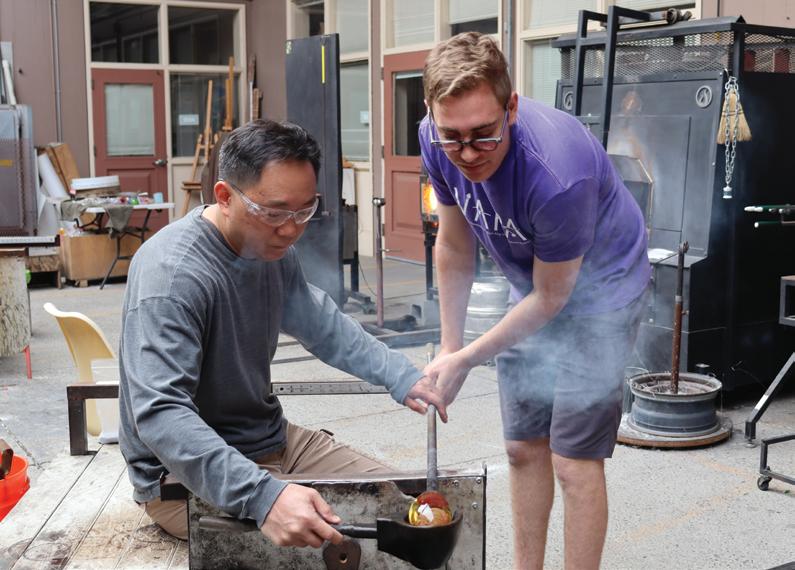
“I think you really need instructors there who have many years of experience both for the beginners to get their skills up and going and for the advanced students to learn some things that they’re not able to teach them selves,” Rosenbaum said.
Despite these problems, Ferrera said there has been a strong support structure for the arts from the school, parents, the community, Partners in Education and Career Technical Education.
“It’s nice being in an educated community because parents have an appreciation for the arts and they know how important it is,” Ferrera said. “ ere’s always ways to nd money, you just kind of have to be resourceful.”
Palo
3 PALO ALTO UNIFIED SCHOOL DISTRICT PALO ALTO HIGH SCHOOL 50 EMBARCADERO RD. PALO ALTO, CA 94301 P A I D PALO ALTO PERMIT #44 NON PROFIT ORG U.S. POSTAGE Monday, Nov. 14, 2022
Alto High School, 50 Embarcadero Road, Palo Alto, CA 94301 Vol. CV, No.
NEWS
LIFESTYLE
B2
PAUSD early literacy rates improve. A2 SPOTLIGHT Special Ed teachers confront communication gap. A4-5
New quarter features Asian American.
Annika Chu Sta Writer
ART BY NIDHI THUMMALAPALLI
ANNIKA CHU/THE CAMPANILE
Fiery Arts instructor Jeremy Rosenbaum helps a glassblowing workshop participant use a block.
Lucy Li Sta Writer
Every Student Reads Initiative improves early literacy scores
According to a variety of standardized test results from last spring, PAUSD improved its early literacy scores. For example, scores increased by 4.3% in the Smarter Balanced standardized tests for third grade students. But some parents say the district isn’t interpreting the data correctly.
District o cials said special focus on the students in the Every Student Reads Initiative –– those who have been historically underserved for the past decade –– resulted in the increases. Scores increased 15.8%, 16% and 8.6% for low-income students, those with disabilities and LatinX students, respectively.
Director of Literacy Instruction Danaé Reynolds said there are several methods of assessment the district and individual teachers use in determining the next steps for a struggling reader. Reynolds said the California Assessment of Student Performance and Progress is an evaluation of districts throughout the state. Regardless, Reynolds said the PAUSD Board of Education has approved multiple ways of reporting literacy results to the community, parents and their students.
“Instead of just measuring progress o of one assessment, we understand that our students are

complex and therefore require more complex evaluation,” Reynolds said. “In addition to CAASPP scores, we turn to classroom level assessments, like tests or benchmarks, that go into the school gradebook and iReady, which is administered three times a year to give opportunities to show growth.”
As a computer adaptive test, Reynolds said iReady has the unique ability to categorize student levels of reading capability into separate domains.
“iReady will show student reading pro ciency within those sections up to three grade levels above or below where they are supposed to be, which gives their teachers a clearer sense of how to continue focused instruction,” Reynolds said. “It also gives valuable insight on dyslexia markers that reading specialists can then begin to tackle with the students
All test results, including the Smarter Balanced standardized tests and iReady assessments, are reported at the third grade level because it is the rst year the tests are administered to students in primary education, and this age group had the time to develop skills within the newly implemented programs beginning as early as kindergarten, ensuring that test results will accurately assess their
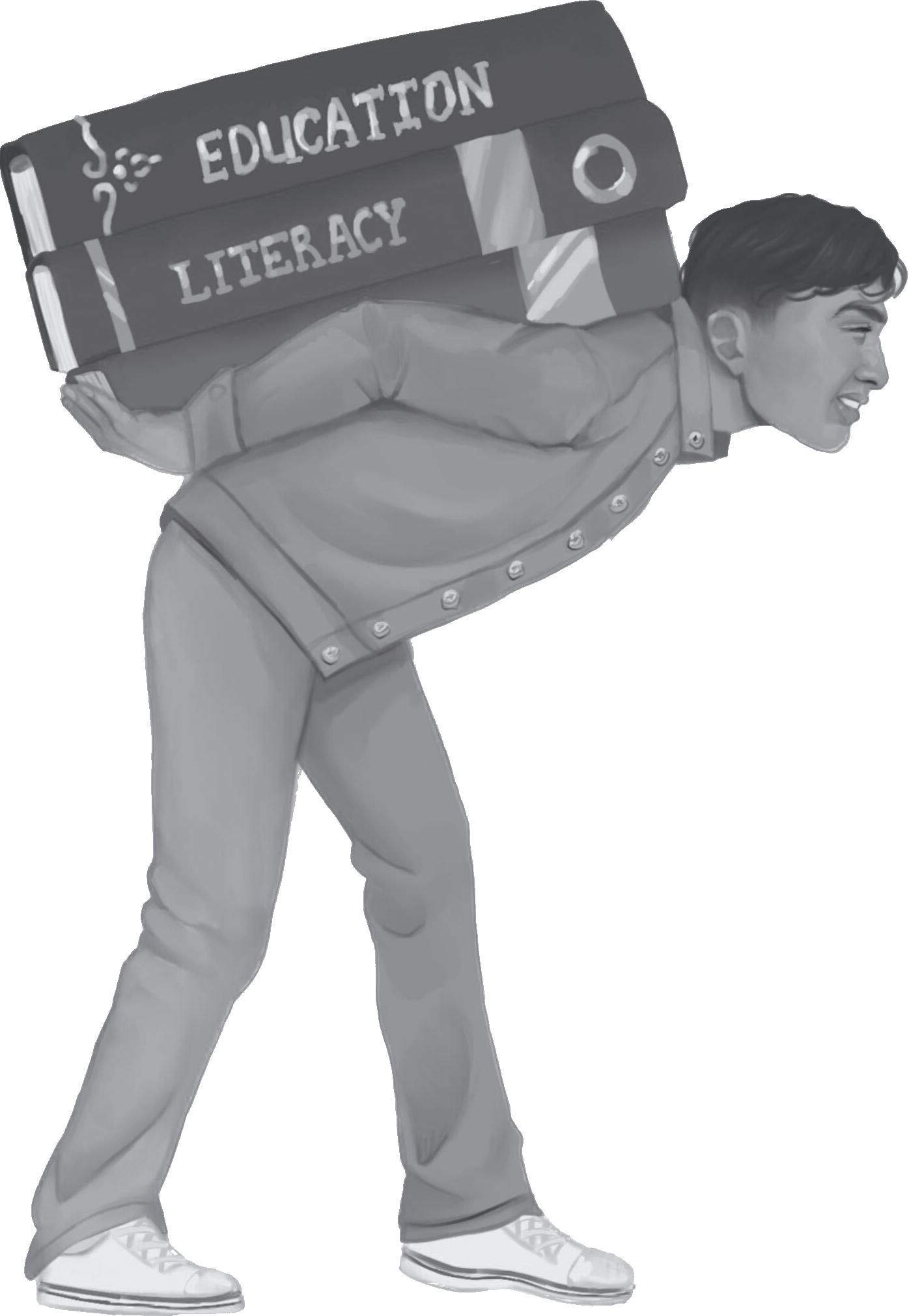
During the pandemic, Reynolds said there was surprisingly greater accessibility to individualized education and access to one-on-one interactions between struggling readers and their English Language Arts teachers through breakout rooms, hybrid schedules and online programs.
“We were able to continue our pursuit of improving literacy because of programs like Epic, a digital library with free access to books and Lexia, a reading platform that provided information on student reading levels through individualized, online computer games on reading comprehension,” ese programs met the students at their levels and supported their development and growth, even o of
With the return to in-person learning last fall, Reynolds said the district is focusing on multisensory
approaches like spelling out words on sandpaper and the Orton-Gillingham methodology of teaching phonics, which is a way of helping students decode the words they are reading, as well as help with their spelling and writing uency.
“It’s actually supportive of all learners that way,” Reynolds said. “It does not single out those who need more support, but at the same time, allows those who want more of a challenge to do so in the same classroom setting.”
Despite the increased test scores and attempts to improve early literacy rates in the district, some parents who have looked at the data are calling for greater district transparency in reporting reading scores.
Two
PAUSD parents, Dr. Allyson Rosen, a neuropsychologist at Stanford and Edith Cohen, a computer scientist at Google Research, said they take issue with the way the district reported test results because the percent increase is unlikely to re ect real improvement on the reading tests. Since the number of students in the district fell substantially after the pandemic and there is naturally high random variation of student scores, the results are statistically insigni cant.
“In the PAUSD literacy case, the progress goals were set to 3% this year, which is too small with respect to the (natural) variation of the statistics,” Cohen said. “ is means that we are nearly 40% likely to see a 3% improvement or drop just from this variation, and the progress goals are almost like tossing random coins.”
Cohen and Rosen said a lack of proper data interpretation can lead to the belief that these expensive programs are working well when the opposite is true.
“A far better approach is to measure average change in individual student scores rather than using the percentage of students meeting standards,” Rosen said. “ at said, the district should be congratulated for avoiding major declines reported in other school districts across the state.”
Moving forward, Reynolds said the district hopes to see that by fourth grade, all students are reading either at or above their respective grade levels.
“ ey are ambitious goals, but we know that our students are quite capable,” Reynolds said. “With (the help of) really strong instructional practices and foundational skills, we can continue to create opportunities for students to think critically and be curious.”
Christie Hong Lifestyle, Sci/Tech Editor
To provided personalized support for students, teachers have been focusing on a framework called Multi-Tiered System of Support.
Used at many high schools, MTSS is a comprehensive method for teachers to help all students, math teacher and Teacher on Special Assignment Deanna Chute said.
Part of Chute’s TOSA work this year is to more formally integrate MTSS schoolwide.
“It’s a framework that’s all about multiple levels of support,” Chute said. “It’s the idea of looking at data to target who needs support in vari ous areas such as academics, behav ioral and social-emotional learning, and attendance.”
Chute said the data comes from records like grades, attendance and surveys that give insight into each student’s performance. Based on the data, the system has three di erent tiers of support according to needs.
“ e rst tier is called Universal Support, and all students get them: PRIME, the Wellness Center, and Advisory,” Chute said. “ en, there’s tier two, which is a bit more targeted, and tier three, which is much more intensive.”
Chute said MTSS helps faculty know how to help each student with their unique needs.
“MTSS is putting student needbased assistance in a structure so that all of the families, teachers and administrators know what the rst
tier of help looks like,” Chute said. “And when this doesn’t work, we try the second tier and so on.”
U.S. history teacher Katya Vil lalobos, who is part of an MTSS fac ulty committee, said the framework is more of a mindset than a program.
“It’s not a program,” Villalobos said. “It’s actually how we think about the school in terms of what we know because we’re a large compre hensive high school.”
Because MTSS is not a districtled program, Chute said it will not be a mandatory, school-wide change.
“Unless the district mandates something, teachers have every right to choose what they do in their classrooms,” Chute said. “ grade what they want to grade, have their own rules, and you can’t change those things.”
But the core ideas of MTSS ensure teachers know what to do when students are strug gling under their supervi sion, Chute said.
“What I’m trying to do is house everybody within a system so that no matter which teach er you are on campus, if they have
a student struggling, they have a variety of things you can try,” Chute said. “So it’s almost like having a menu that has options that teachers can choose from, and you’re not go ing to see uniformity across campus.”
Villalobos cited the Peer Tutoring Center and school therapists as ex amples of rst-tier support programs already implemented.
She also said because the school already has resources that many schools do not, MTSS is based on improving resources the school has rather than focusing on the resources it lacks.
Cayden Gu & Jerry Xia Editors-in-Chief
Motivational speaker Timothy Alexander spoke in the PAC during study hall on Nov. 4, remind ing seniors to challenge themselves to excel under pressure and enjoy their senior year.
“I came to Paly to remind the students that it’s not about what you go through; it’s about what you grow through,” Alexander told e Campanile. “Challenges are di culties that lead to growth. I want to challenge students to control what they can control and respond the best way they can respond.”
Principal Brent Kline said Alexander wanted to come speak again after a conversation about the Sept. 9 Paly-Gunn football game.
“During that whole time, I was talking to our friend TA on the phone, and he was giving me lots of advice and inspirational words because I was frustrated,” Kline said. “During those conversa tions, all of a sudden TA said, ‘Brent, I need to come back.’”
roughout his speech, Alexander emphasized the importance of committing oneself to making the best decisions possible, even if they are tough.
“One of the challenges I give to you today is not just to make a decision, but to choose to live with the decision that you make,” Alexander said during his speech. “I challenge you to make a deci sion in your senior year to enjoy every single day.”
Senior Anna Wingard said she appreciated Alexander’s speech because it applies to her life.
“I really loved the speaker,” Wingard said. “He helps me have a better outlook on life and a more positive way to think of struggles and barriers I’m going to face in my life.”
Alexander also spoke to faculty the morning before the speech. English Teacher Hunter Rear don said Alexander presents a clear message that students can identify with.
“I think he does such a good job of labeling some of the challenges and struggles that his audi ence is facing,” Reardon said.
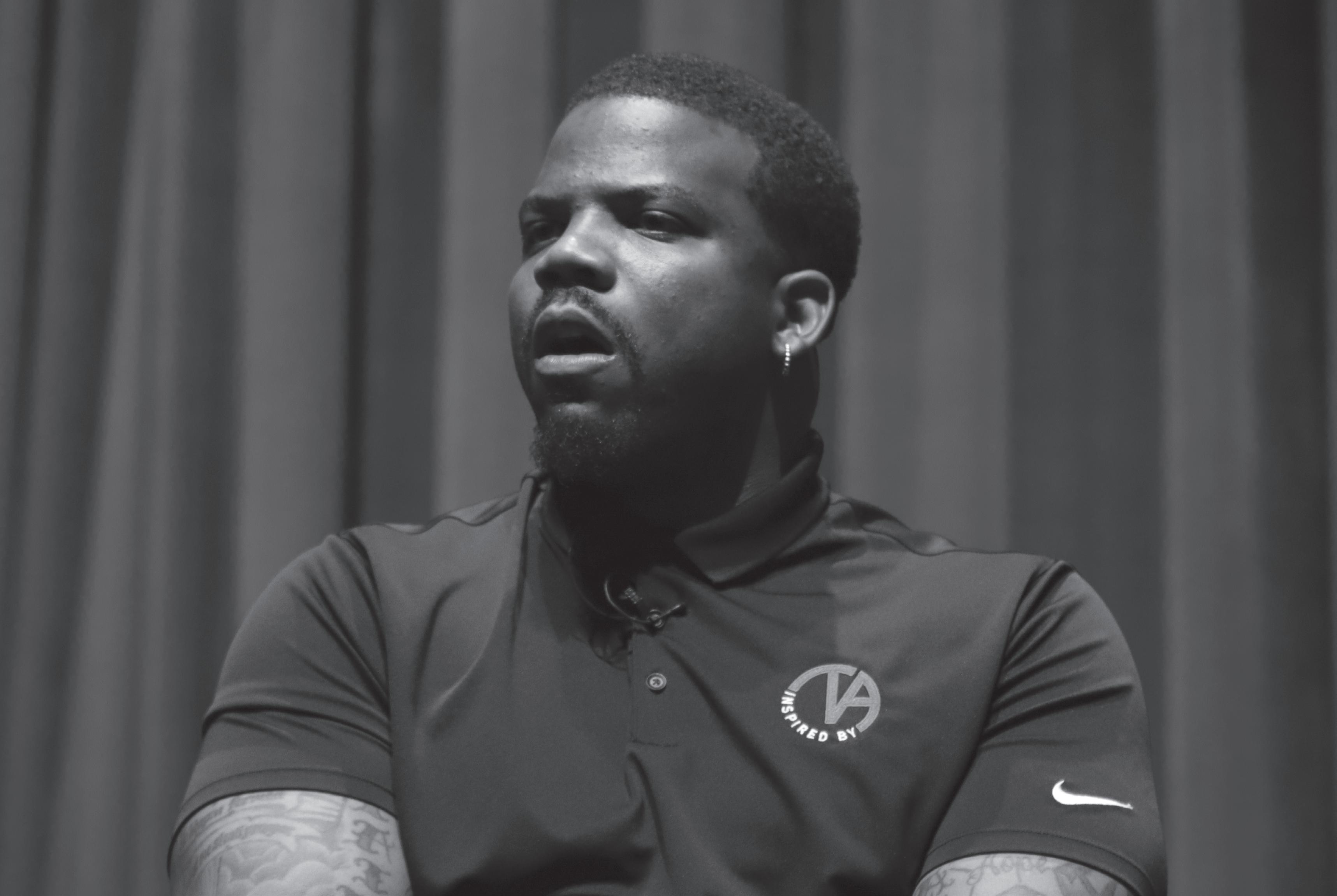
Reardon said he thinks Alexander’s message could motivate students to confront and overcome the challenges they are facing in Paly’s competitive environment and grow from the experience.
“I think there are students here that are going to need that extra push,” Reardon said. “ ey have the skills. ey have the ability and the resources. I think a lot of students need to be reminded that struggle can be productive.”
Alexander said he appreciated the opportunity to speak to the senior class and concluded his speech by reminding them to stay positive.
“You all made me feel loved,” Alexander said. “Remember, we don’t need it to be easy. We just need it to be possible.”
“It’s seeing what you already have, making improvements and making sure that the students have access to those support systems,” she said.
Villalobos also said MTSS has evolved during her time at PAUSD to o er greater social-emotional support.
“When I rst encountered it a long time ago, the research was on the idea of RTI, or response to in tervention,” Villalobos said. “RTI is a way of targeting students that need additional support, but one thing that we noticed at the administrator level is that students didn’t just need academic support, they also needed social-emotional support.”
erent
“Many of the elements of MTSS have certainly been at Paly, but structuring them with that mindset has been stopped and started over the years.” Chute said. “ ere are many teachers on this campus that have been working hard in these areas for a number of years, but a lot of reasons, like COVID-19, slowed the movement.”
is year, teachers have begun to implement MTSS through their work in committees.
“Right now, we’re looking at how we use the technology that we have to make it easier to make sure that we’re getting that information out there,” Villalobos said. “We hope that we can have something available for teachers sometime at the end of January for the second semester.”
And Chute said MTSS’s success is based on communication and col laboration among teachers.
easy to keep an
“It’s all about getting the adults on this campus talking, collaborat ing and working together to support kids with strategies,” Chute said. “With adults in the right places providing the right help (and) get ting all that kind of lined up, I think students will have an even healthier learning environment.”
Shiki Toyama Business Manager
Monday, November 14, 2022 News e Campanile A2
CAYDEN GU/THE CAMPANILE
ART BY THEA PHILLIPS
Timothy Alexander encourages seniors to live in the moment during an assembly in the PAC on Nov. 4. “I challenge you to make a decision in your senior year to enjoy every single day,” Alexander said.
In ation shifts consumer demand
In a period of historically high in ation in the U.S., many Town & Country businesses say they have had to raise prices to combat supply and sta ng chal lenges, creating pricing concerns among students.
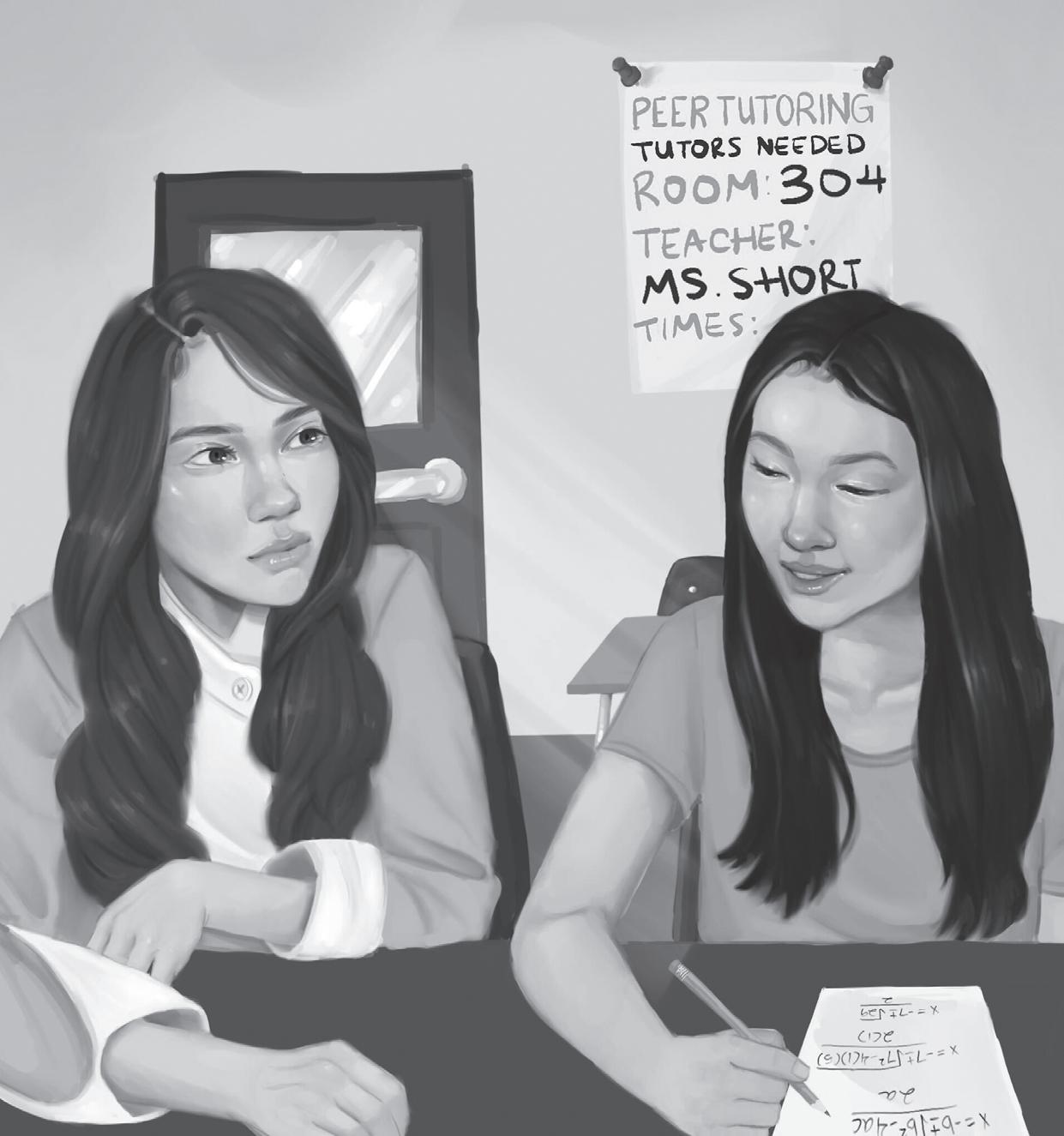
According to the U.S. Department of Labor, the price of consumer goods increased by 8.2% in September compared to the 12 months prior. In ation has remained above 8% since March 2022 and reached a peak of 9.1% in June, far above the Federal Reserve’s target range of 1-3%.
Economics teacher Grant Blackburn said in ation is caused by changes in supply and demand. Black burn said consum ers tended to save money during the COVID-19 restrictions but are now spending it, driving up prices, and supply chain problems have made the problem worse.
“ ere’s pent-up demand from the pandemic because people have not done anything for a year and a half,” Blackburn said. “ at means they’ve saved up a lot of money, and they’re excited to get out and do something. e other part of it is sup ply. e supply chain and all the businesses that provide goods and services have been disrupted.”
Blackburn also said in ation creates inventory and pricing challenges for busi nesses, especially because higher prices can reduce the number of customers a business has.
Rosie Cetina, manager of Poké House at Town & Country, said the price of a poké bowl has increased by about 50 per cent since the beginning of the pandemic because of the increased price of sh.
“We increased the price three times after the pandemic, which can be a con cern, especially for students,” Cetina said. “However, our quality is the same, and our portions are still the same.”
Cetina said she has noticed fewer cus tomers as prices have risen. Additionally, Cetina said wage increases for employees to account for in ation has put Poké House under more pressure.
“Managing the employee situation has been di cult,” Cetina said. “We needed to increase wages to help employees. We also had to reduce hours by about two hours per week for the ones working part-time to save on costs.”
However, in ation has not a ected all businesses equally. Romel Avrina, manager of Boba Guys at Town & Country, said in ation has only marginally increased supply costs.
“ e price of dairy has gone up, and that’s a blanket increase across all of our drinks,” Avrina said. “Oat milk and rice

sider spending less at Town & Country.
“( e prices) will probably a ect my spending habits a little bit,” Wang said. “I’ll consider bringing more food from home because I think the prices will prob ably go up more in the future.”
Over the last four months, the Federal Reserve raised national interest rates on loans by 3% to increase the cost of bor rowing. Blackburn said increased interest rates slow the economy and thus reduce in ation, but it will take months for the situation to improve.
“ e idea is that if people spend less, businesses will see fewer customers come in the door, and in order to entice more people to come, they’re going to lower their prices. But that’s not going to hap pen until people feel enough of a pinch.”
Blackburn said the Federal Reserve has to walk a ne line between lowering in a tion and crashing the economy.
“We don’t want in ation to get out of control because if it keeps going, it will feed on itself,” Blackburn said. “If we taper down too much, it’s going to create
Editor-in-Chief
little bit of inconsistency, because we need to source particular items to be within our sales budget,” Avrina said.
Senior Andrew Wang, who goes to Town & Country every day for lunch, said while the price increases are inconvenient, he understands businesses have to meet increased costs given the current economic climate.
“I think the deals for students were pretty good, so it makes sense for the prices to go up,” Wang said. “I think (Town & Country businesses) would prob ably be losing a lot of money if the prices didn’t rise. It’s still generally a fair price.”
Yet, Wang said the prices have made him con
Peer Tutoring Center to relocate
To accommodate the increasing number of students utilizing the Peer Tutoring Center, administra tors have relocated it to a larger space and are planning to expand its hours and access.
Fewer students used the center following COVID-19 and online school, but Peer Tutoring Center adviser Mayerly Short said she now sees up to 40 students a day.
“We have a lot of di erent tu tors and tutees, so there is a good mixture,” Short said.
Previously located in room 408, the center has moved to room 304 to provide for more students. Short said she hopes the resources at the center will become more accessible to students.
“I want (the center) to expand and become a more central resource that everyone can use,” Short said. “I know a lot of kids are a little scared to ask, but it’s OK to have help, and if students need it, then I want to provide it.”
Junior Asha Kulkarni, who started volunteering as a peer tutor this year, said she thinks the current system operates well.
“I didn’t know that the peer tutoring center existed when I was a freshman,” Kulkarni said. “But (this year) it’s always crowded whenever I’ve been there, and it’s full for PRIME.”
Kulkarni said a challenge does exist in terms of maintaining a bal anced student-to-tutor ratio. Still, she is optimistic that the center will continue to operate smoothly.
“It’s di cult to organize be cause of the huge volume of kids,” Kulkarni said. “My hope for the center is that everyone is matched with a tutor who can help them when they need it.”
While the center is currently open only during PRIME and after school until 5 p.m., Principal Brent Kline said the center has the poten tial to reach more students.
“We’re looking to see if we can expand this to support a greater number of kids,” Kline said. “I would love to increase the time that we o er tutoring.”
Kline said extending the hours of the tutoring center would make it more equitable for students who participate in extracurriculars im mediately after school.
“My hope would be for the center to be open from the begin ning of school and past the end of the school day so that students with preps or downtime in a class can go seek some help if they need,” Kline said.
With the room to accommodate more students, Kline said he hopes to reallocate funds to ensure the center is consistently sta ed. Kline also said they’re looking to integrate non-student tutors.
“We are trying to see if we can expand beyond peer tutors,” he said. “We have been looking at getting more tutors from the community, like parent volunteers and maybe people from Stanford University.” Short said she is enthusiastic for these changes that will provide more academic resources and hopes the center can support as many students as possible.
“ e Paly community is lled with students who participate in sports, theater and other extracur riculars,” Short said. “I just want to make sure that their grades are up, so they can all have the best time here they possibly can.”
Li Sta Writer
Holocaust survivor Ben Stern spoke to Social Justice Pathway students on Oct. 26 about his experience during World War II and the importance of learning about survivors’ stories.
“I want to thank you for giving me the chance to speak,” Stern said.“I know that it’s hard to connect (to me), but I’m here to relay (my story).”
Stern, 101, was born in Poland in 1921 to Jewish parents. He was separated from his family by Nazi soldiers at 17 and survived ghettos, death marches and multiple concen tration camps. He was liberated by the U.S. army in 1945, and he now shares his experiences from the Holocaust to advocate for social justice.
Stern’s daughter, Charlene Stern, accompanied him to the event.
Charlene said the main thing she wanted students to take away from the event was that the best way to ght against injustice is to have compassion for others.
“ e weapons of courage, kindness and hope are the best way to live a life of integrity and purpose,” Char lene said. “I encourage everyone to nd their courage, kindness and hope because you never know what life has ahead.”
Social Justice Pathway English teacher Mark Tolentino said he invited Ben and Charlene Stern to speak because SJP students are studying
“We’re exploring existence and religion and the role that it plays (in the book),” Tolentino said. “Students were bringing these theories into their interpretation of ‘Night.’”
Tolentino also said the speaker event was a rare opportunity to bring history alive.
“Unfortunately, Holocaust survivors are aging out,” Tolentino said. “We don’t have too many more opportuni ties to have this (event).”
SJP junior Eloise Durma said the audience was lled with emotion dur ing the event.
“ ey are so well spoken and pro found,” Durma said. “People were just crying in the audience.”
Durma also said the event was helpful in putting what she has learned in class into perspective.
“You read about the Holocaust, but it’s not that real to you,” Durma said. “But then you get someone who’s an actual Holocaust survivor, and that makes it so much more real.”
Charlene said her father’s mission to advocate for oppressed groups and to show kindness to everyone following his experiences in the Holocaust is inspirational and incredibly rare.
“My father’s story is the story of someone who lose everything,” Charlene said. “He picked himself up, let go of hate and went on to open his heart to the world.”
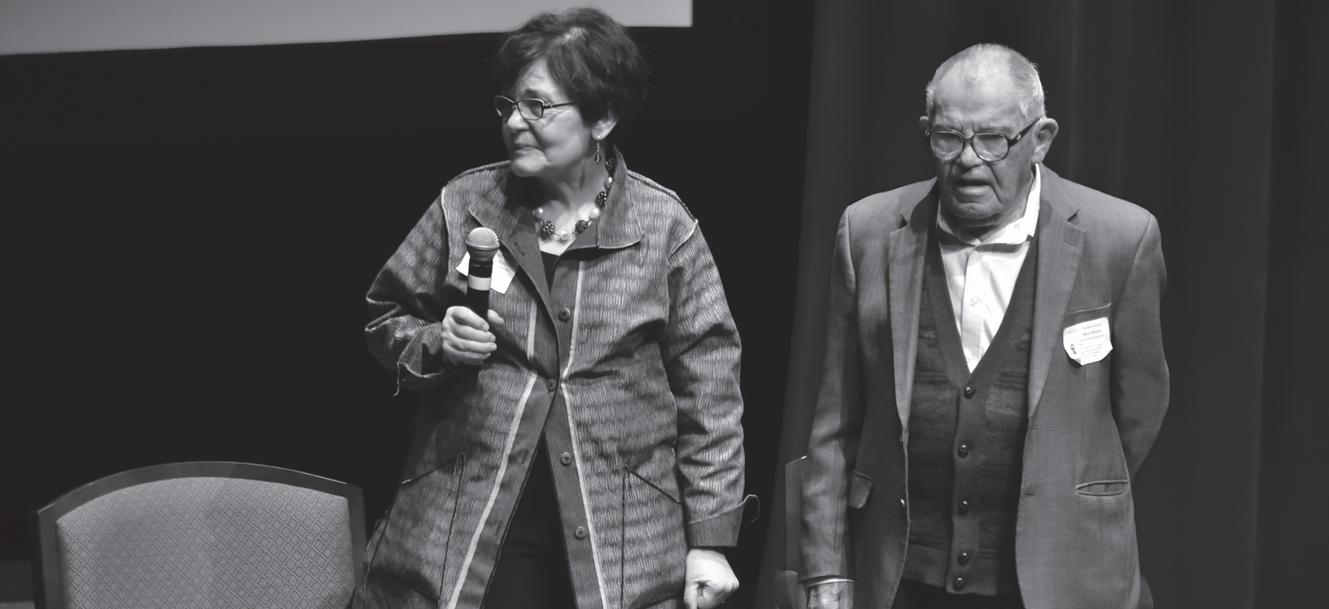
Monday, November 14, 2022 News e Campanile A3
existentialism in the memoir “Night,” by Holocaust survivor Elie Wiesel.
Lucy
Shamsheer
Sta
Singh
Writer
ART BY KIARA TAVAKOLI
CAYDEN GU/THE CAMPANILE
ART BY IVY LEE
Jerry Xia
Holocaust survivor Ben Stern shared his experience during World War II with Social Justice Pathway students. Stern’s daughter, Charlene, accompanied him to the event.
HE IPPING OINT
With 10.1% of PAUSD students qualifying for special education services, district and site level administrators say they are constantly focusing on improving the program to give these students the extra help mandated by law.
However, some teachers and parents say PAUSD does not adequately support special education teachers or students and fails to provide the resources that special education students need to succeed.
Special education rights grow over time
After President Gerald Ford signed the Individuals with Disabilities Education Act into law in 1975, public school districts were federally required to provide free, appropriate education in the least restrictive environment.
Steven Davis, a parent of children in PAUSD’s special education program and founder of Disability News Wire, an organization that promotes equal accessibility and inclusivity for students with disabilities, said nding education for special education students was di cult before IDEA.
“Before it, kids with disabilities had no rights or expectation of education,” Davis said. “Schools would just say, ‘Yeah, we’re not teaching your kid.’”
Amendments passed in 1990, 1997 and 2004 mandated additional educational opportunities for students with disabilities in public schools and expanded the scope of IDEA.
IDEA has allowed more than 7.5 million students with disabilities to access free public education and special education services designed to t their needs, according to the U.S. Department of Education.
Special education advocates say IDEA has pro vided students across the nation with the educational resources to become economically self-su cient and live independently. However, within the last ve years, California has struggled to keep up with the law’s regulations.
e Department of Education categorizes each state in one of four categories regarding how well they are implementing IDEA in their public schools: meeting requirements, needing assistance, needing intervention and needing substantial intervention. A report in June of 2022 classi ed California as “needing assistance” in meeting the requirements of IDEA parts B and C, which cover special education and early intervention services.
Yet, based on test scores, PAUSD has done a better job at meeting these standards than the state average. According to Disability News Wire, the 1,087 PAUSD students with disabilities in 2021 scored 71 points higher in math than all students with disabilities across California and 94 points higher in English Language Arts.
Briana Gonzalez, a Gunn special education teacher, said part of the reason for the success of PAUSD special education students on these tests is that the district integrates these students into the regular education classroom through a co-teaching model where classes are taught by both a general education teacher and a special education teacher.
“(We) have education specialists who have all the skills to make content accessible (to) make sure we’re reaching all learners, and we’re bringing that into the Gen Ed curriculum,” Gonzalez said. “We’re creating comprehensive but accessible standards and meeting all the learners in the room.”
While the co-teach ing system is relatively new and not without its aws, Principal Brent Kline, who oversees Paly’s special educa tion program, said it is constantly evolving.
One of the legal responsibilities of special education instructors and co-teachers is to attend Individualized Education Program meetings to determine a student’s IEP plan. Special education teachers write IEPs while co-teachers attend the meetings.
An IEP meeting lays out the special education in struction, support and services a student with disabili ties could potentially qualify for.
According to the Judicial Branch of California, these meetings must happen at least once a year and require the attendance of a general education teacher, a special education teacher, a school administrator, the student’s parent and the student if they are 14 or older.
Program su ers from lack of transparenc y

However, inconvenient IEP attendance requirements and a lack of communication from administrators have caused many teachers to feel confused and frustrated.
Teri Baldwin, president of Palo Alto Educators Association, PAUSD’s teachers union which negoti ates employment terms with the school board, said IEP meeting times depend on the parent’s availability.

10.1%
“ e level of under standing and the e ec tiveness of that partnership between special education and general education teachers continues to grow into a better program than we have already,” Kline said.

“For an IEP meeting, it’s de nitely dependent on the parent’s schedule,” Baldwin said. “It trumps anybody else’s unless it’s after school and somebody just can’t be there. en, they try to schedule when everyone can be there.”
Due to the priority given to parents’ schedules in this process, several special education teachers told e Campanile that they are e ectively forced to attend IEP meetings even if these meetings are held during the teacher’s contractually mandated
e Campanile Spotlight Monday, November 14, 2022 A4
prep periods. ese teachers also said they do not receive compensation for this time.
All the special education teachers interviewed for this story agreed to be interviewed only if their names were not used because they said they fear reprisals if they speak out against the current system.
“As a special education teacher, we regularly have IEP (meetings), and I have been told by administration and people from the district o ce on more than one occasion that I must use my prep time and not be compensated for it,” one special education teacher said.
But a Memorandum of Understanding between PAUSD and PAEA, which is an agreement outlined in the teacher contract that is not legally binding, says special education teachers will be compensated for meeting time that accumulates to more than six outside-of-school hours in a semester. Baldwin said PAEA and PAUSD negotiated to reach this threshold.
“We tried to get it for any hours outside of the workday,” Baldwin said. “And the best we could negotiate was six hours per semester.”
PAUSD lead negotiator Lisa Hickey originally agreed to an interview for this story, but one day later, fellow PAUSD lead negotiator Trent Bahadursingh said he and Hickey could not comment on negotiations.
However, Kline said teachers can ask to be compensated for any prep time they have to give up for IEP meetings.
“Teachers have the discretion to ask for additional compensation,” Kline said. “So maybe they don’t understand completely what the process is.”
In an email sent from Kline to the Paly sta in October of 2020 and obtained by e Campanile through a public records request, Kline wrote, “It is the professional responsibility of all certi cated members to attend IEP meetings of students in their classes, including such meetings that are scheduled during planning periods.”
In a follow-up email sent to Paly PAEA Representatives eight days later, Kline corrected himself and wrote, “In my next communication to sta , I will revise my messaging so that it aligns with the collective bargaining agreement, … which includes the choice to attend or not attend IEP meetings.”
Another special education teacher said they were unaware they could ask to be compensated for IEP meetings held out side of school hours.
“It was never presented as an option,” this teacher said. “I’ve never been told that, and I never thought to ask.” e rst teacher said this lack of clarity on this issue is partly rooted in the high administrator turnover rate at Paly.
“ is is my fourth principal,” the rst teacher said. “Nobody seems to understand all the components of the program.”
While Assistant Principal Jerry Berkson, the only administrator who has been at Paly for the past 17 years, said the changes in administration are generally bene the school, he also said it is too early to tell whether the current administrative team can e with the special education program since many decisions regarding special education happen at the district level.
e team we have right now is probably the best team I’ve worked with as a whole,” Berkson said. “I think everyone has di all complement each other in a lot of ways.”
e rst anonymous special education teacher said this separation of administrative responsibilities between the district and school leads to an additional communication gap.
“(Decisions) about the program and its money are typically made at the district level or the mid-management level,” they said. “ ere’s this whole other world where the admin on site (at) my job is in charge of what
Lack of funding a ects students, teacher
In addition to a lack of transpar ency, the special education teachers interviewed for this story said they feel unsatis special education.
“Our district seems to brag about how much money we’ve saved,” the rst teacher said. “I able. You mean you saved $10,000 (instead of) spending that in a way that could have bene Shame on you. Why would you be proud of that?”
Another special education teacher said the district should provide more funding for the program.
“ ere needs to be more money put into the depart ment because these are our most vulnerable students who need the most sup port,” the second teacher said. “And if (it) is our promise that we are serving all students, we need to put the money where the needs are.”
Kline said he disagrees with these teachers’ comments about special education funding in the district but did not elaborate.
Another problem facing the special education department, according to the rst special education teacher, is that PAUSD hires substitute teachers when a special education
teacher is absent instead of paying other on-campus special education teachers, even though the substitutes may not have special education teaching credentials.
“Somehow it ful lls the need (when) the sub has no knowl edge of special education (and) no knowledge of how to work with students with disabilities,” they said. “Sometimes having a sub show up is more work because you’re just trying to tell that sub what to do, or we’re paying someone not to do anything.”
Gonzalez said Gunn faces similar issues due to a national shortage of teachers and substitutes with special education credentials.
“It’s an overall issue in the eld of special ed that, due to high turnover, we do not have a lot of substitutes available with special education credentials, and we do not have a lot of teachers with special education credentials applying for jobs, unfortunately,” Gonzalez said.
But Kline said the district is following all state protocols regarding subs.
“You don’t need speci c credentials to be a substitute,” Kline said. “You just have to have a teaching certi cate.”
Parents call for change
Davis, whose children are in PAUSD’s special education program, also said the district does not fully recognize or appreciate the e orts of special education teachers in other PAUSD schools.
“We had Teacher Appreciation Week last year, and for the general ed class, they had owers and all these other things,” Davis said. “And there was no setup or support for the special ed teachers.”
Another parent of two special education students at Paly said the lack of communication from administration has made student progress unclear. ey agreed to an interview only if their name was not used to protect the privacy of their children.
“Administrators never reached out and asked us or any other parent if we think (special education teachers) are e ective,” the parent said. “When you’ve got a class where what you’re pro viding is support, it’s much harder to determine whether that support is e ective and whether what they’re doing is actually making a di erence.”


Baldwin said special education is still a work in progress, but PAEA continues to provide proposals to the district in an e ort to improve the program for everyone.
Baldwin said, “We’re trying to negotiate better language in the contract to help out special education, special education teachers, general ed teachers and the students that are in special ed programs.”
In addition to Bahadursingh and Hickey, special education instructional leader Christina Dias declined an interview request for this story. None of the members of the Board of Education responded to email requests for interviews. Gunn administrators Courtney Carlomagno and Wendy Stratton initially agreed to interviews but did not respond to follow-up requests.
Monday, November 14, 2022 Spotlight e Campanile A5
“
ere needs to be more money put into the department because these are our most vulnerable students who need the most support.” — Anonymous teacher
Students should prioritize sleep over work

It’s 1 a.m. I’m at my dinner table, slumping over the expanse of schoolwork spread out before me. I urgently ip through my physics notes, looking for an explanation that is probably not there. After two minutes, I give up and crack open my computer.
Among the 15 tabs open, a Google slideshow glares out at me. irty-six circular icons pop into the top right corner of my screen.
I guess I’m not the only one working this late, alone and struggling to stay awake.
As an honors student surrounded by competitive overachievers, I know how hard it is to cram homework, extracurriculars and a social life into one 24-hour day. However, prioritizing sleep is more bene body and mind than staying up past midnight to nish schoolwork.
According to an American Academy of Pediatrics study, 75 percent of 12th graders received less than the recommended eight hours of sleep compared to only 16 percent of sixth graders. As students get older and their schedules become busier, their sleep durations decline.
ere are numerous factors that lead to insu cient sleep among teenagers, and I’m sure everyone has heard them before. Old schoolers blame the disruptive electronic devices that alter our circadian rhythms, inhibiting our ability to fall asleep at a reasonable time. Parents fault schools’ early start times. Some students blame their poor sleep habits on their ca eine addiction.
Regardless, insu sleep can lead to multiple consequences, both short and long term.
According to the National Library of Medicine, sleep deprivation leads to reduced attention span, lack of energy and worsened memory.
A continuous lack of sleep can lead to sleep debt, a cumulative e of lack of sleep, which is often associated with anxiety, depressive symptoms and even suicide.
Let me reiterate this. Staying up late to memorizing your history
vocabulary will not only be challenging because of your reduced attention span due to a lack of sleep, but you might not be able to remember those vocab terms the next morning because of your worsened memory.
Showing up late to rst period in sweatpants, holding a half-empty Peet’s co ee cup and parading a backpack stu ed to the brim with notebooks and crumpled paper is common enough at Paly that no one seems to notice how tired you are. As soon as you nd your seat, the rst conversation of the day starts o with how much sleep you got the night before.

work themselves to the bone. In Palo Alto, the most dedicated students are seen as the ones who work late into the night because they have to attend their extracurricular activities and maintain their social life.
However, these societal pressures only enforce that a student’s self-worth is tied to what they accomplish in a given day, which encourages students to stay up later to study.
While most students are aware of the detrimental e ects of sleep deprivation, they make no e ort to change their sleep schedule or combat these cultural customs.
To those who brag about getting less sleep than others or how they drink ve cups of co ee before 9 a.m., stop promoting this sleep culture.
e hustle lifestyle is imaginary and pressures students to compare themselves to other students. It is creates a dangerous culture that not only ruins people’s mental health, but physically damages their body as well.
Instead, the hustle lifestyle should encourage genuine, healthy productivity rather than the counterproductive sleep deprivation it glori es.
When your peers brag about sleep deprivation, don’t give in to the temptation to participate in what shouldn’t be a competition.
Acknowledge that your sleep schedule is something that needs to
Singer News/Opinion Editor
Clocking into a tiring eight-hour shi at my job at Starbucks every weekend for several months straight was incredibly draining. However, I do feel that the experience has built my character and shaped me into a more resilient person.
Part-time jobs provide teenagers with numerous bene ts and valuable lessons. Upperclassmen should get jobs since teen employment can promote money management skills and advance other necessary qualities such as ac countability, communication, coopera tion and time-management.
I did not have the most wonderful rst part-time job experience at the Starbucks drive-through. However, a er re ecting, I’m ultimately thank ful for the experience as I’m more equipped to handle similar situations in the future.
I was able to experience an intense work environment with picky, rude customers now rather than later.
Most high schoolers, especially upperclassmen, have the resources to acquire a job. Many stores in the food service industry hire employees start ing at 16 years old, and many students obtain their driver’s licenses at this age, so they can manage their own transportation to and from their jobs.
When teens begin the job-search process, many of them are immediately exposed to aspects of professionalism, especially depending on where they apply to work. Students must do their own research on what businesses are hiring, ll out applications, submit resumes and contact supervisors and managers.

e hiring process is a learning experience in itself: learning about possible interview questions and how to answer them is a crucial part of the job experience.
On top of this, the inherent nature of customer service jobs helps to teach students accountability, responsibility and interpersonal skills. For instance, having to develop the “customer is always right” mentality can be easier said than done, but by interacting with challenging customers, teens can develop patience and communication skills.
I’ve had my fair share of “Karens,” and while frustrating, I think these experiences have taught me how to maintain my composure in stressful situa tions.
Student em ployees must also take on a new load of responsi bilities, as well as a new perspective on discipline.
is will help to improve their reliability and e ciency.
For example, employees cannot skip work just because they don’t feel like going, and if they’re sick, then it is their responsibility to nd someone to cover for them.
ey will realize that their absence at one shi will make everything more grueling for the rest of the sta that day, meaning they will be held ac countable for their decisions.
Additionally, jobs allow teens to be responsible for their own money. As teenagers learn how challenging it is to make money, they will be more aware of their spending habits and become more appreciative of what they choose to buy.
Many high schoolers may be hesitant to get a job because they think
they don’t have the time in their sched ules or because they are more focused on excelling in school and athletics. While balancing all of these obliga tions is challenging, it only encourages students to improve their time-man agement skills.
When I was overscheduled at work due to our store being understa ed, I struggled to balance everything. However, many employers are accom modating to high school students, and nding a exible job with an ap propriate number of hours per week can provide teens with the perfect balance between school and work.
Additionally, many students fail to realize how sheltered their school environ ment is, as many grow used to the school bubble and don’t have experiences outside of it.
Being thrown into a work environ ment with adults, many of whom have been working full-time for years, is a jarring experience, but it exposes us to the struggles of maintaining a job.
Ultimately, upperclassmen should have a job before graduation and before they have to live as adults in the real-world.
Maintaining a job while keeping up grades and athletics can be strenu ous, but the bene ts for the future are undeniable.
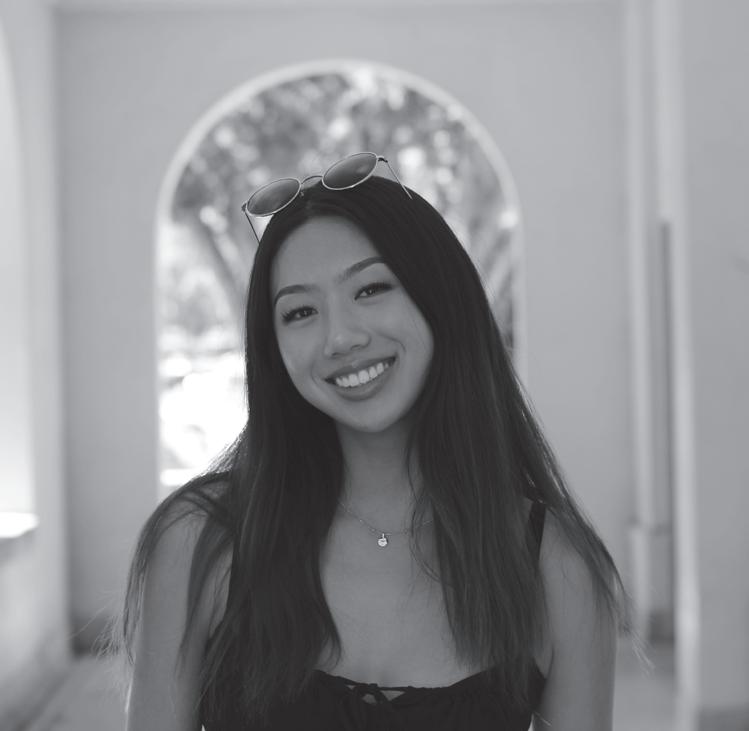 Brianna Zhou Sports Editor
Brianna Zhou Sports Editor
Monday, November 14, 2022 Opinion e Campanile A6
ART BY GRACE HE
ART BY KATE XIA
Hannah
Twins should be treated as unique individuals
had eight minutes alone in this world; my sister followed my lead a few chaotic minutes after. Since then, I have spent most of my life with my twin.
Whenever I meet someone new and they nd out I have an identical twin, they often ask, “How do I tell you two apart?”
Since I was young, people have been mistaking me for my identical twin, Gaby. Some teachers have gone as far as to think I’m one person with two di erent names.
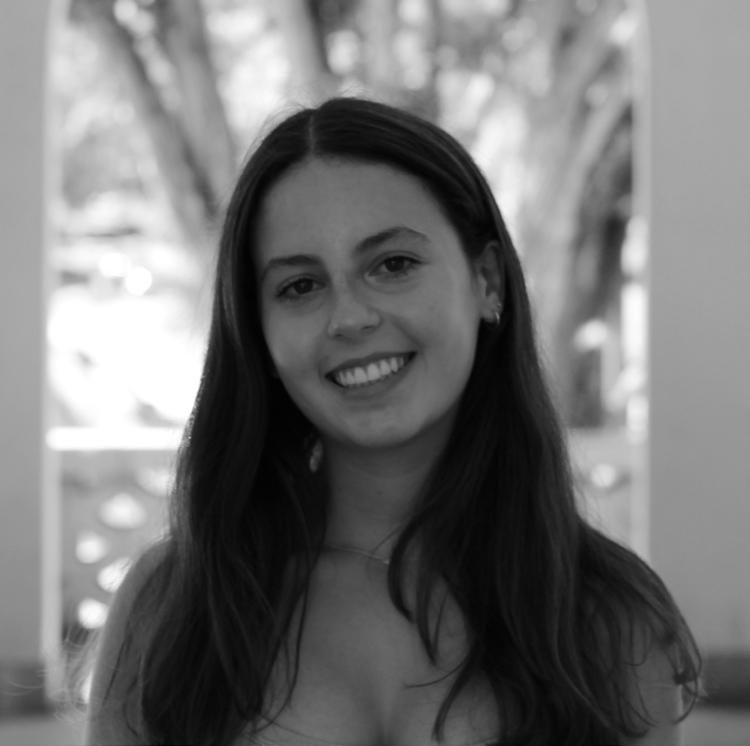
I know it’s not their fault when people mistake me for my twin because we do look pretty similar. My twin and I surprisingly have
When people see us apart, they often ask, “Where’s your twin?” ey see us as individuals when we’re together, but they see us as incomplete when we’re apart. Yet, this is ironic because we are more individual apart than together.
Many people also tend to refer to us as “the twins.” ey ask questions to one twin and don’t make an e ort to ask the other because they likely either assume we’ll have the same answer or that we speak for each other.
ese interactions feel dehumanizing because I become an object instead of a human, lacking basic human rights like free speech and
with my twin because we try so hard to be di erent from one another so that people don’t treat us like we’re the same person. Treating twins as individuals is crucial because it allows us to dress, speak and act the way we want without worrying about what people will assume.
So, treat twins as two people who happen to be born on the same day. Refer to us by our names and not “the twins.” Because when I look in the mirror, I don’t see my twin. I see me; when I look at my twin, I don’t see me. I see her. When you look at us, see two unique individuals.
ough being a twin is a big part of my ne who I am. Instead, I am a collection of my own experiences and er in every person, even
In short, I love my twin, but people need to realize that we are not a package deal.
Guan Guest Writer
In the age of polarization, statements and personal lives no longer matter.
It’s hard to believe that just 10 years ago during the 2012 Presidential Election, Republican nominee Mitt Romney faced considerable backlash for saying “corporations are people too” and using the phrase “binders full of women” at one of the presidential debates.
Yet now, during the 2022 Midterms, these comments hardly appear unusual given the colorful rhetoric employed by the current Republican party.
From the myriad of Senate and House candidates such as Harriet Hageman, Blake Masters and Adam Laxalt saying the 2020 Presidential Election was stolen, to Sen. Ted Cruz’s allegation that the man who attacked Paul Pelosi is actually a “hippy nudist from Berkeley” that Democrats are trying to paint as a right-wing extremist to discredit the Republican party, it seems no theory or statement is considered too politically costly to publish.
ese developments are alarming. We’ve historically used the words of politicians to judge their character because it’s the best glimpse we will ever get of their personalities, values and morals.
But if we no longer care about what politicians have to say, how can we even attempt to tone down polarization in this country?
External observers have long pointed to a “sweet spot:” the optimum position on the political spectrum where prospective politicians stand to attract the maximum number of voters.

But in this new age of polarization, there appears to be two distinct spots on the spectrum for politicians: either extremely liberal or extremely conservative.
e majority of supporters of both parties are too far away from the political center, destroying what is left of the middle ground.
e polarization of political centers means more politicians will have to make statements contrary to their beliefs to have any meaningful hope of an election victory.
at means we’ll no longer be able to trust what politicians say.
And if we can’t trust what they say, how can we ever anticipate what they’ll do once in power?
How can we ever predict what the o cials we elected will do?
Even actions are no longer enough to hold politicians accountable.
Erik Feng Managing Editor
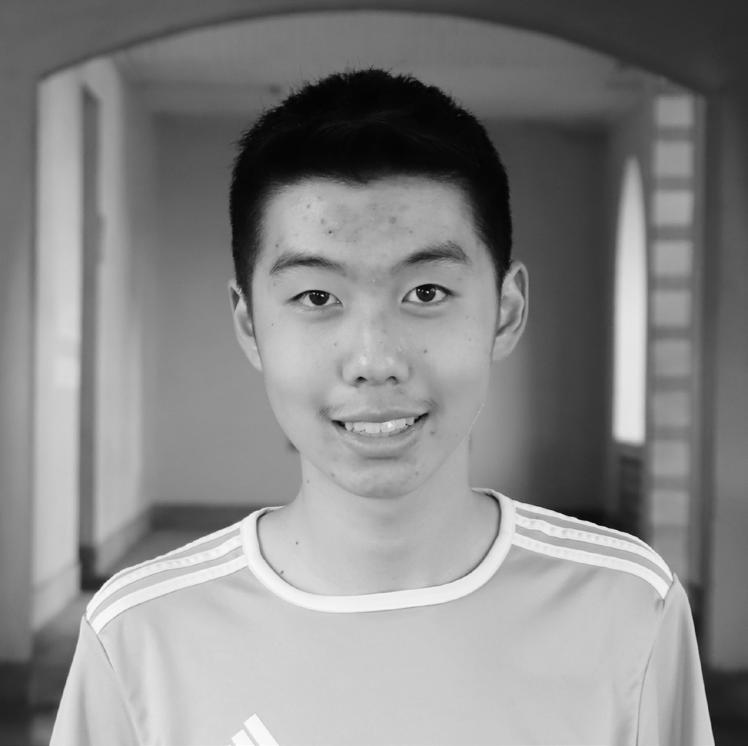
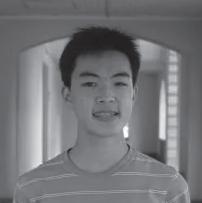
Immediately after Halloween, radio stations and stores – and maybe your friends – insisted on playing “Frosty the Snowman,” even though Christmas is still more than a month away.
According to Statista, 85% of people report enjoying festive music, but for some people, Christmas songs are not reminders of jolly memories but instead are memories of missing out on the promises of the holidays and its stress-inducing ties to holiday shopping. Because of this, playing Christmas songs before anksgiving Day is a mistake.
While I advocate against playing Christmas music before anksgiving Day, I do not think an individual who listens to this kind of music by themselves, or alone or with headphones, should change their music selections. People should listen to whatever they want as long as no one else can hear it. However, in cases where the music is broadcast to the public, people should be careful about the general acceptance of Christmas-themed music.
While many say the sentiment of early November to December is jolly, the holidays are not a univer sal oasis of joy, warmth and excite
ment. For some, Christmas serves as a reminder of nancial strain. Because Christmas songs tend to be romantic, hearing Christmas songs might also intensify feelings of loneliness and missing out.

Playing Christmas music before anksgiving also ruins the vibe of the late-fall tradition.
While the history of anks giving is problematic –– don’t even get me started on the hypocrisy of Black Friday being the day after anksgiving –– the general reason to celebrate anksgiving is to give thanks.
By playing Christmas music, which many people associate with holiday shopping, people are less likely to think about giving thanks and more about holiday deals.
While the spirit of winter holi days and anksgiving are similar, they are ultimately di erent.
e holiday season is commonly de ned as the period between anksgiving and the New Year, and such music should be played during, and only during, this time.
Also, because popular Christmas songs tend to be simple pop songs, people are likely to get tired of them by Christmas.
According to Dr. Michael Bonshor of the University of She eld, an expert in music psychology, repeatedly listening to a simple song can decrease the appreciation for the song.
If you stream Christmas music before anksgiving, people are likely to become tired of the festive songs by the time Christmas spirits are supposed to be high. e most commonly played Christmas songs are simple pop songs. Especially because the top Christmas songs like “All I Want for Christmas is You,” “Jingle Bells” and “Frosty the Snowman,” are all simple songs, people are very likely to become tired of the songs by Christmas if they’ve heard them for two months. I doubt you’ve genuinely enjoyed the 17th time you’ve heard the bell chimes at the beginning of Mariah Carey’s “All I Want for Christmas is You.” By playing
It’s natural to feel the lure of Christmas and the holidays in November. With the weather getting colder and days shorter, the cues for winter are everywhere. But while it may already feel like Christmas, it’s not. Let’s not lose the spirit of the fall. is year, let’s not saturate November with the same songs. Turn on the (virtual) replace instead of listening to “Baby it’s Cold Outside” on repeat? It’s cozier and more relaxing.
Perhaps the greatest example of this is Hershel Walker, the Republican nominee for the Senate in Georgia whose personal life became fodder for the media.
After establishing his opposition to abortion rights, multiple women he was previously in relationships with came forward with allegations that he had paid them to have abortions.
Plus, news organizations revealed Walker had fathered three illegitimate children he never previously acknowledged.
Yet despite how damaging these reports may appear, they’ve hardly made a dent in Walker’s approval rating.
e latest poll, conducted by the Remington Research Group on Nov. 2, showed a four point lead for Walker in the Peach State.
So perhaps we can view actions as a window to the character of politicians, but why does it matter if they’ll poll well and potentially become elected regardless?
If I’m honest, I never anticipated it would get this bad. e United States is at a turning point; inequality, polarization and divergence in values have all played their part in pushing us further apart.
I’ve seen many commentators compare this time in our history to the years before the American Civil War, which is a particularly concerning observation.
Wars start when people no longer see themselves as belonging to the same nation.
Regardless of the outcome of tomorrow’s elections, that’s what we must never lose focus of –– no matter what contrasting views we hold, we are all American.
We all belong to the same nation, and we all want the best for it. Nothing will ever change that.
Monday, November 14, 2022 Opinion e Campanile A7
Christmas-themed songs only af ter anksgiving, people are likely to become more spirited, despite hearing Christmas music for a shorter period of time.
ART BY HANNAH SINGER
Lucas
ART BY RACHEL LEE
Elizabeth Gulman Sta Writer
I
Editorials
ART BY VIVIAN LIN
PAUSD should provide accurate assessment of literacy rates
To help improve the reading level of elementary students who have fallen behind due to online school during the pandemic, PAUSD launched the Every Student Reads Initiative last year. eir main goal was to increase the percent of third graders who meet or exceed the English Lan guage Arts standard on the California Assessment of Student Performance and Progress test by at least 3%.
Superintendent Don Austin told the school board in September that the district had exceeded its goal of a threepoint increase compared to 2019 in the percent of all students who read at or above the state standard.
Scores for students speci cally targeted by the Every Students Reads Initiative — mainly low-income, dis abled and LatinX students — showed larger increases of 15.8%, 16% and 8.6%, respectively.
However, PAUSD parents have raised concerns that the district may be misusing data, especially because read ing scores for most of the country have fallen due to the pandemic.
e Campanile thinks PAUSD should provide more transparency when sharing data about student performance and focus on supporting all students by improving its reading programs in ac cordance with teachers’ suggestions.
While the district’s report on reading achievement showed the three-point improvement, the Report on 2022 Literacy Results published online by two PAUSD parents, clinical neuropsy chologist Allyson Rosen and computer science professor Edith Cohen, said this improvement is not signi cant enough
to statistically prove the district’s literacy program is a success.

According to the parents’ report, a 3% improvement in scores has a 37% prob ability of occurring without any changes to teaching, suggesting the results have little statistical signi cance and are more accurately attributed to luck than the district’s new reading program.
Furthermore, the results from the ELA portion of the CAASPP test for PAUSD elementary schools do not show a clear trend in reading perfor mance and trends are not consistent across the district’s 12 elementary schools.
For example, the percent of Walter Hayes students who met or exceeded the standard for ELA increased by 3.75% from 2018 to 2019 but decreased by 8.16% in 2021 and decreased another 1.74% in 2022. e percent of Addison Elementary students who met or ex ceeded the standard for ELA, mean while, decreased by 3.97% from 2018 to 2019, increased by 4.65% in 2021 and decreased by 1.01% in 2022. Results for 2019-2020 were not reported because testing was suspended that year due to the COVID-19 pandemic.
Because scores have gone up and down by a few points for many years without the Every Student Reads Initia tive, a 3% increase is not a large enough change to conclude that the district’s elementary school reading rates have improved, nor a large enough increase to praise the success of a new reading program.
In addition, while reading rates may have shown some improvement, the number of historically low-performing
While PAUSD Special Education does an admirable job supporting students with disabilities from early childhood through high school, e Campanile thinks administrators must increase e orts to ensure greater communication with teachers and the quality of teacher-training to promote suc cess for these students in high school and beyond.
PAUSD’s special education program has proven itself to be among the top in the state. In the 2021-22 school year, 15.33% of California students with disabilities met ELA standards and 3.9% met math standards. On the other hand, 90.71% of PAUSD students with disabilities meet ELA standards and 37.5% meet math standards — a noteworthy contrast that clearly illustrates the program’s recent success.
In addition, with robust programs such as pre-school intervention, the FUTURES program and the Project SEARCH vocational Internship Program, PAUSD’s special education program is actively preparing its students for post-secondary opportunities.
Yet, while PAUSD has demonstrated glimpses of excellence in special education instruction, there are still concerns that prevent the program from truly ful lling the PAUSD Promise on Special Education and Inclusion, which calls for high-quality programs and services in a regular, nonseparated educational environment.
While a 2016 professional review conducted by law rm omas Hehir & Associates found PAUSD students with disabilities experienced higher-than-average rates of inclusion, and their performance was comparable to that of students without disabilities in the rest of California, the same review found some troubling patterns.
Hehir and Associates found that special education parents frequently lacked information about policies, practices and procedures related to accommodations and special education, resulting in a large portion of parents distrusting the district.
And transparency of information remains a key concern in PAUSD special education. Even between administrators and
students who attend PAUSD schools decreased by 38% from 2019 to 2022, according to the two PAUSD parents’ report, suggesting arti cial manipula tion of the data through exclusion and discrimination.
Besides transparency issues, PAUSD has been inconsistent with its curricu lum selection. According to a Palo Alto Online article from May, the board of education voted to adopt a new reading curriculum, the Benchmark Advance/ Adelante Program, for the 2022-2023 school year without any obvious reason and despite substantial opposition from the English Language Arts Pilot and Adoption Committee, composed of parents, teachers, specialists and admin istrators from all elementary schools and grade levels.
Teachers said the Benchmark Advance/Adelante Program does not adequately serve disadvantaged students, especially those with Individualized Educational Plans, because of its onesize- ts-all philosophy.
While the district says its new curriculum will support underserved students and champions the success of the Every Student Reads Initiative, this assumption appears to be built on manipulated data.
e Campanile thinks taking short cuts that prioritize the district’s image over equity in education is unacceptable, especially because reading is a basic skill everyone needs to lead a ful lling life. PAUSD should report transparent data and use this data alongside input from teachers about the type and execution of curriculum to provide an e ective education for all students.
BY HANNAH SINGER & SHAMSHEER SINGH
The Campanile
teachers, poor communication hinders the department’s ability to uphold the PAUSD Promise.
Two anonymous special education teachers told e Cam panile that the department experienced unclear guidance from administrators over if and when IEP meetings should be held. Moreover, they said many teachers are unaware that they can receive compensation for the many hours they spend on these meetings per semester.
It is imperative that communication between administra tors and teachers is thorough and clear.
When teachers do not have a complete understanding of their expectations, they can not accurately ful ll their responsibilities.
At the end of the day, how well teachers can perform their jobs directly translates to the success of the students, especially in special education.
When special education teachers are forced to hold IEP meetings during class time, PAUSD does not mandate substi tutes for these classes be special ed-certi ed. Special education students have spe ci c, unique needs that require individual attention. While there are understandably many challenges, e Campanile implores PAUSD to prioritize training and hire quali ed substitutes for special education classes.
While PAUSD frequently prides itself on its ability to save money, special education is not a department that can a ord to operate on tight budgets. To cut costs in special education means to place the district’s most vulnerable students at even greater risk.
e Campanile recognizes the strides PAUSD has made in advancing special education services for students. But if the district wants to continue as a leader of special education in the state, it must play its role in promoting strong com munication and high-quality teacher and substitute training to ensure the PAUSD Promise of Inclusion for all students is met.
&
like to thank the PTSA for supporting the mailing of our newspaper.
e Campanile has upheld the highest standard of student journalism for the last century by engaging the community through various mediums of storytelling. Our coverage of news, culture and athletics aims to represent the diverse perspectives of our student body.
Illustrators
Elise Andrade Ariana Cao Grace He Jada King Ivy Lee Vivian Lin ea Phillips Hannah Singer Kiara Tavakoli Katie Wu Kate Xia Cherianne Yoon Writers Olivia Atkinson Isabella Bian Annika Chu Lucas Guan Elizabeth Gulman Gabriella Gulman Claire Jittipun Albert Jung Lucy Li Gavin Lin Neel Sharma Dhruv Shetty Shamsheer Singh Luca Vostrejs Nidhi ummalapalli Editors-in-Chief Margot Blanco • Rachel Feinstein • Cayden Gu Justin Gu • Jerry Xia
Photographers
to the Editors: Email all letters to editors
e Campanile prints
Campanile
Adviser Rodney Satterthwaite Letters
to theeds23@googlegroups.com.
letters on a space-available basis. We reserve the right to edit submissions. e
only prints signed letters. Adver tisements: Advertisements with e Campanile are printed with signed contracts. For more information regarding advertisements or sponsors in e Campanile and their size options and prices, please contact e Campanile Business Managers by email at campanile.ads@gmail.com. Note: It is the policy of e Campanile to refrain from printing articles that misrepresent or alienate speci c individu als within the Palo Alto community. e Campanile would
Our Vision Statement:
Ti
Sports Editors Dinu
Managing Editor
Lillian
Business Manager
Lifestyle, Sci/Tech Editors
News/Opinion Editors
any He Hannah Singer
Deshpande Brianna Zhou
Erik Feng
Clark Christie Hong
Shiki Toyama
Art Director Rachel Lee
Naveen Narayanaswami
Monday, November 14, 2022 A8 e Campanile
Lifestyle
Acting passion
with
poison


Paly eater premiered its rst production of the year, “Radium Girls,” from Nov. 4-13.
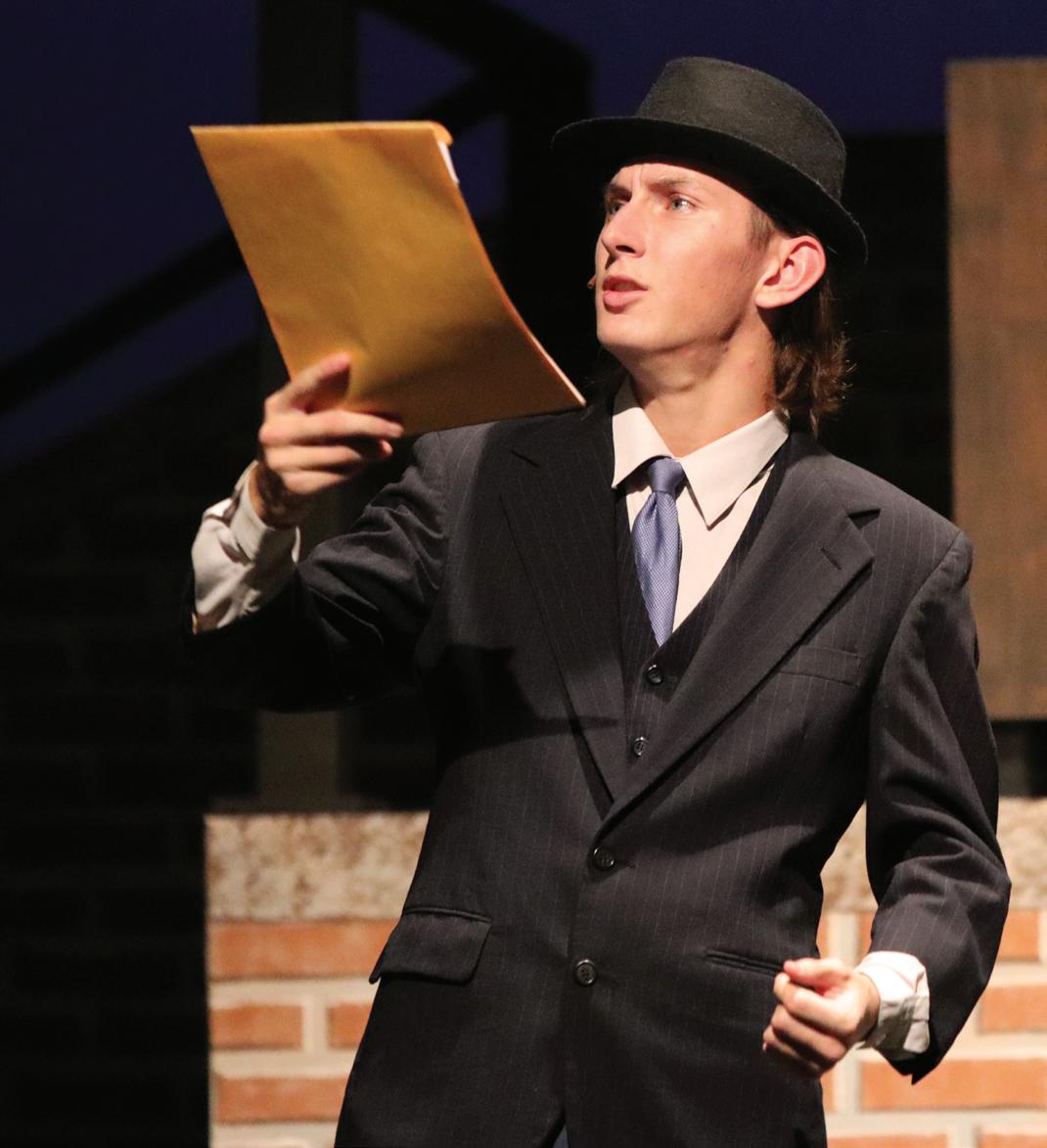
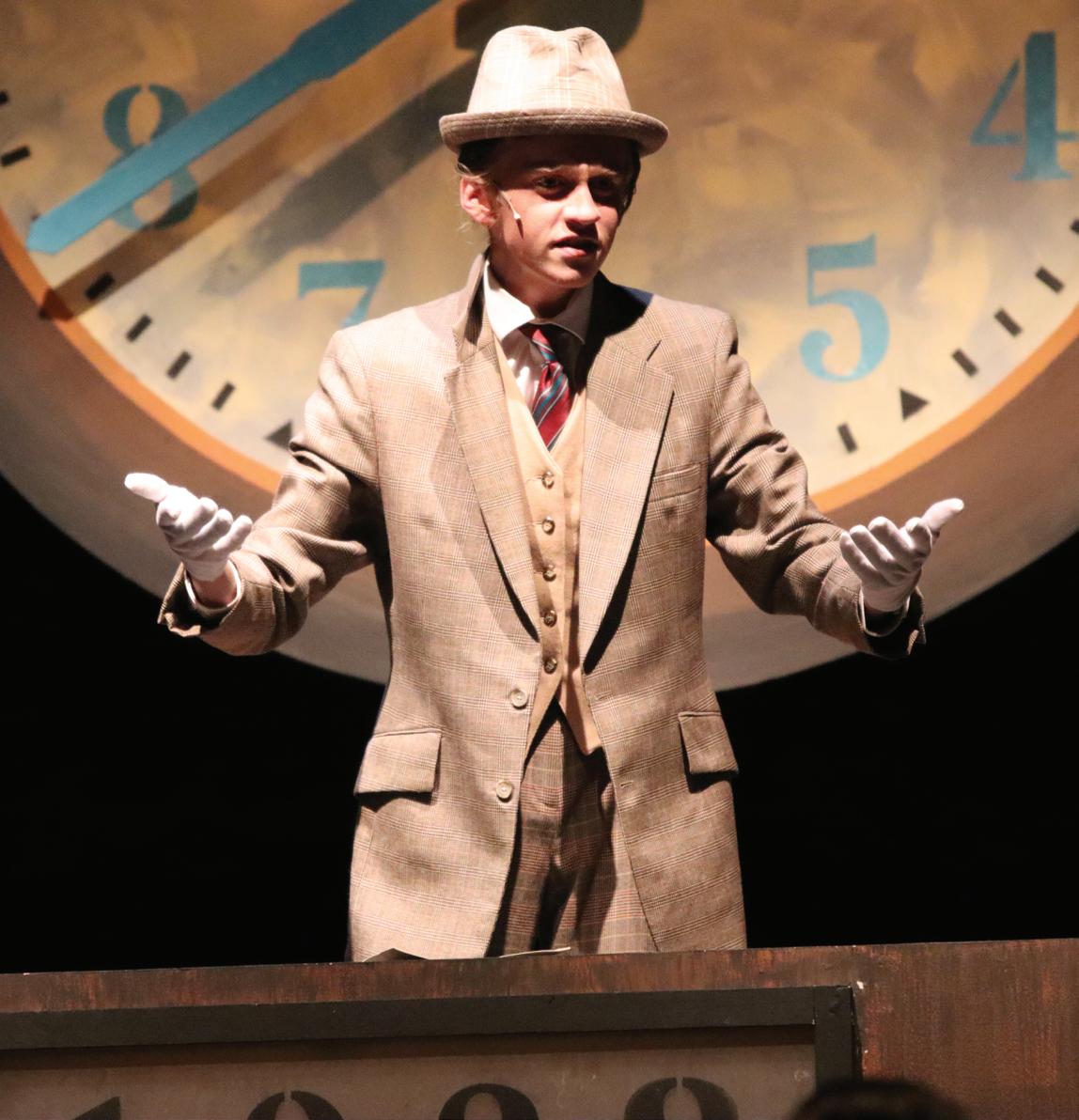
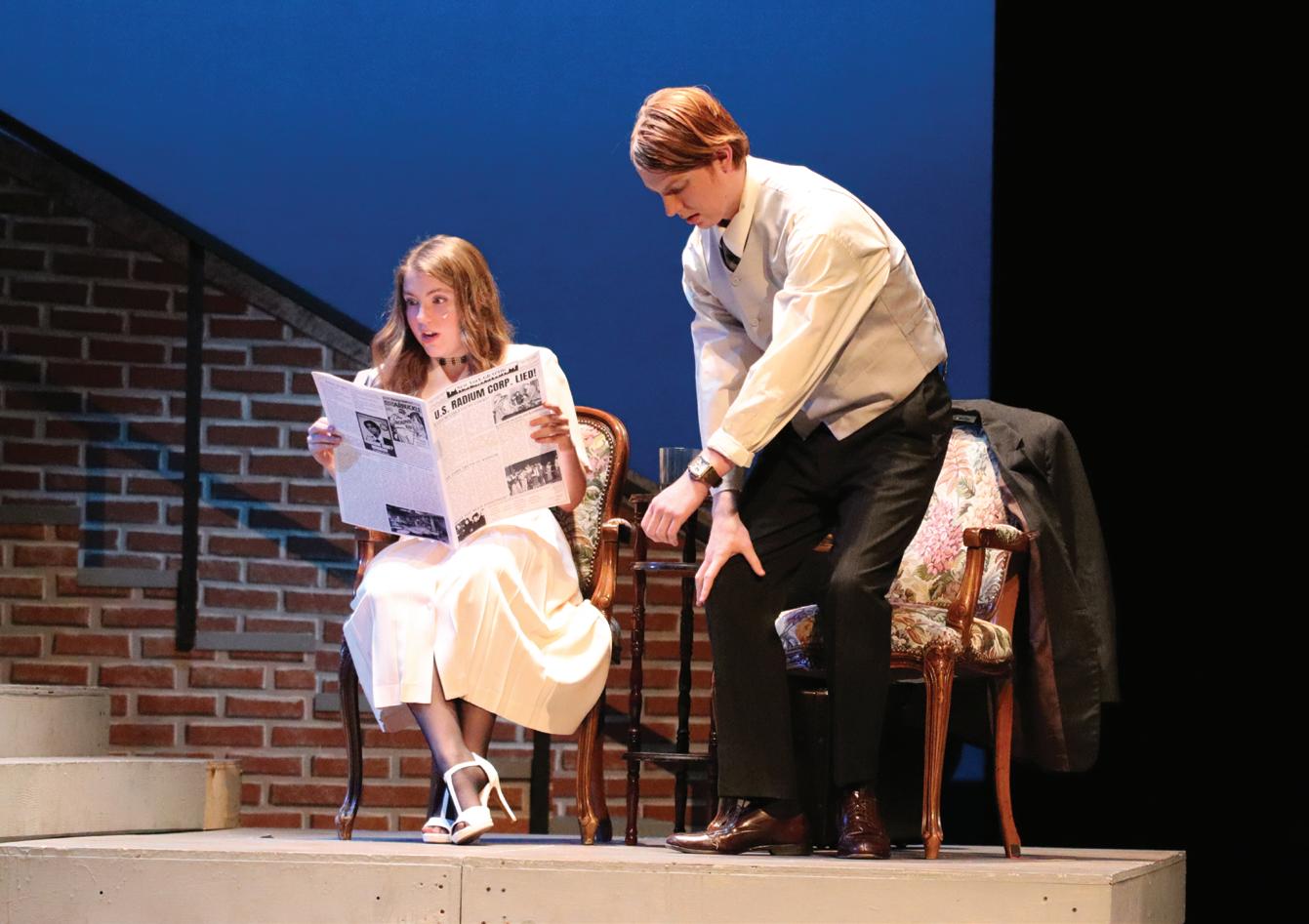

e play fol lows the story of women who work in a watchmaking factory in the 1920s, painting the hands of watch faces. e women use radium in the paints to make the numbers on the watches glow in the dark; however, it is later found that radium is radioactive and dangerous.
Co-director and theater teacher Sara ermond said “Radium Girls” demonstrates how sexism, power dynamics between employers and employees and ma nipulation of the press silenced the problem of radium poisoning.
“It is very much rooted in a historical event, but I think it has a lot of themes that are important for society to consider, even in the present day at this time,” ermond said.
After two consecutive years of fantastical and light-hearted shows, ermond said she decided to start o the season with a histori cal play to give students more variety.
“I wanted to do something that would give the (student actors and designers) the expe rience of incorporating more research and his tory into their work in preparation,” ermond said.
Senior Mina Fry, who plays the lead role of a factory worker who raises awareness about the radium poisoning, said due to the historical nature of this play, she had to pay particular attention to how she represented her character.
“When you are trying to portray all the real life trauma (a character that was a real person) went through, you have to be a lot more sensitive than if you’re just playing a fantasy character,” Fry said.
When thinking about how we were going to do certain scenes, we had to think about how to portray the illness (of the radium girls) respectfully,” Vargha said. “We wanted to do it in a way that did not romanti cize it but still got across the horrors of (their illness).”
Head costume designer Noah Boyarsky said the costume department spent a lot of time preparing accurate costumes that matched the style of the 1920s.
“We de nitely put more time into research for this play, which is hard because the further back you go in history, the less documentation there is,” Boyarsky said.
“It ended up being really rewarding when we man aged to make costumes that actually t into the right cultural era.”
In preparation for the play, the crew mem bers spent their time gathering information. Boyarsky said it is important to ensure that both the production crew and the students with acting roles are well-versed in the spe ci c details of the time period, which applied to their respective specializations of the set.
“One of the great parts about working on a histori cal show is that everyone is collaborating to do historical research,” Boyarsky said. “ hair and makeup (department) is doing their research, and the direc tor knows a lot about the era.”
Boyarsky said his favorite aspect of creating a play is seeing the nal prod uct come together.
“What I like about theater is that everyone’s work comes together between departments, like the acting, directing, lighting, hair and makeup,” Boyarsky said.
Vargha said the departments collaborated to make artistic changes that di ered from the radium girls book, such as the inclusion of a scene where a character is smoking to remark on the same lack of knowledge on the harmful e ects on consumer goods.
“You can’t change the actual dialogue, but through the performances, you can add certain depth,” Vargha said.
Although the performances are over, er mond said she hopes the themes and mes sages from the play will continue to be shared.
“My big goal is to express something that is based on real people to move the audience to emotions over the experiences of all of these characters,” ermond said.
Vargha said she hopes the audience takes inspiration from the factory women who stood up for their rights.
Vargha said,“If you are facing an injustice, you should try to advocate for yourself and ght for what is right.”
Sta Writer
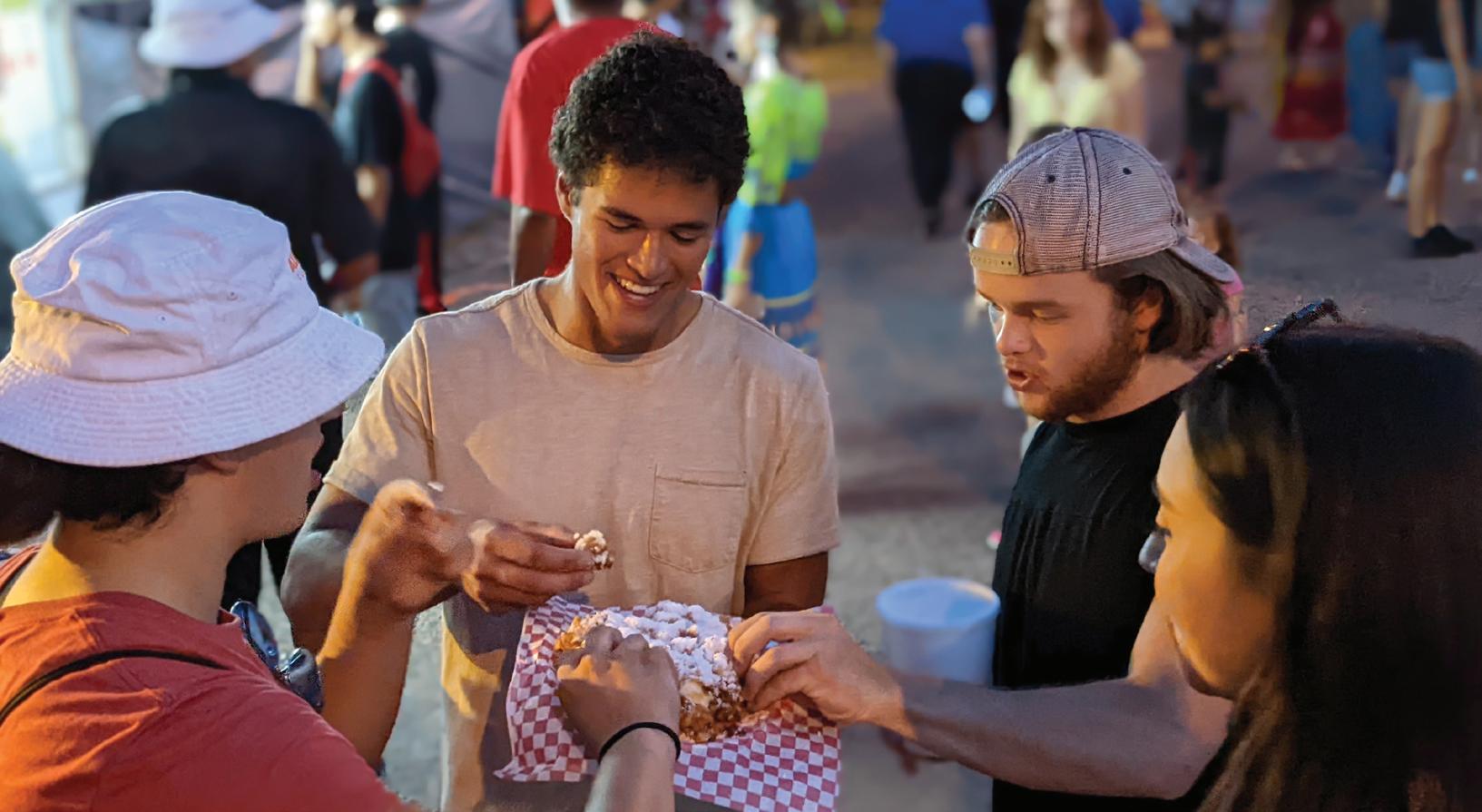 Sta Writer
Sta Writer
With traditional music in his ear and a sacred pipe in his hand, alumni Palo Silva, class of 2022, participates in the blessings of the powwow ground.
Silva wrapped up his summer in Flandreau, S.D., immersing himself in Native American culture as part of the American Exchange Project.
is project allows graduating seniors from the U.S. to travel to another town for a week in order to bring together youth from around the country.
Last summer, eight Paly seniors participated in the project, and this summer will be the third time the project has run.
“I wanted to do something new,” Silva said. “I wanted to go to a community that was dif ferent than how I’ve lived my whole life.”
e trip taught Silva to listen to other view points and avoid preconceived biases.
“It’s important to just go out and meet dif ferent people and listen to them.”
rough meeting others, Silva said he learned people have more in common than most believe.
“People might have di erent opinions and whatnot, but at the end of the day, we’re all hu man,” Silva said. “Everyone still wants the best for one another.”
Valerie Chu, who also graduated from Paly last year, spent a week in San Angelo, Texas with the program.
Chu said she came out of the experience with more open-mindedness.
“People are more similar than di erent, even when they come from di erent parts of the country,” Chu said.
Economics teacher Debbie Whitson, a volunteer for the project, said the goal of the project is to bridge the political gap in Ameri ca by bringing together its youth.
“Every high school student after gradu ation will have a chance to travel for a week in a town unlike their own and experience a homestay, talk with people who have di erent values (and) meet kids from di erent areas to put a human face on these people who we’ve villainized,” Whitson said about the American Exchange Project.

Senior Bella Daly, who plans to participate in the program this summer, heard about it from members of the dance team. She said she hopes to learn more about di erent people across America.
Nidhi ummalapalli Sta Writer
With domestic strife, including the Jan. 6 insurrection at the Capitol and increasing par ty polarization, extremist narratives continue to divide America, and the idea of autocracy is slowly becoming a reality. e concept we constantly deem alien to our pristine democ racy will come for us, if we don’t take action.
To address these issues, we must explore the role individual communities play in shap ing each facet of our government.
Your power as a citizen to maintain or reform existing institutions extends beyond the polling booth and into relatively mundane habits like reading the news. Being aware starts with steps as simple as signing up for a variety of publica tions with di erent audiences. For local news, consider reading Palo Alto Online, which is acces sible through the PAUSD ID portal. For national news, sign up for e New York Times or the Wall Street Journal, both of which are free for PAUSD students, or the Washington Post. As for international news, try reading the BBC, which covers erent countries.
Routine tasks such as keeping up with the world around you can counter informa tion asymmetry, or misinformation, while also informing your personal and political deci sions. It can also help us form and maintain relationships, become more grounded in real ity and increase empathy.
Beyond reading the news and voting, go to congressional town halls and advocate for reform. Topics like police budgets, education and healthcare can be addressed by local gov ernments in addition to the federal govern ment. By speaking on these issues at a district level and providing individual input, you can contribute to the government taking a less bu reaucratic stance on these topics. When ful ll ing Paly’s community service requirement, get involved with local organizations that resonate with your values and interests.
Most of us live in a bubble that does not re ect the rest of the U.S. e Bay Area is a more privileged microcosm of U.S. society, so we have the resources and capabilities to in spire reform. However, we tend to wield that sword in the opposite direction, since most of us can a ord to shut the news o and claim that politics don’t a ect us.
Except it does a ect us, now more than ever. Our politics are moving in retrograde, and we live in an era where government mis trust and su ocating party extremism prevail.
At this time, we must de ne our intrinsic values, stand rm in our well-informed beliefs and perform our civic duties so we aren’t swept away by the rolling tides of each party.
“I hope to gain a better understanding of what it’s like to live somewhere unlike the Bay Area, especially since I’ve never lived anywhere else,” Daly said.
Ultimately, Silva said he is grateful for his experiences with the American Exchange
Program, which have helped him understand di erent perspectives.
Silva said, “It was a spiritual and cultural experience that I’ll never forget.”
For more information, go to https://ameri canexchangeproject.org/students/.
e Campanile Monday, November 14, 2022
Student assistant director Sophia Varga said that special attention was given to ensure that the play did not trivialize the
Palo Silva discovers unique traditional foods at festivals during his summer abroad in Flandreau, South Dakota. “I wanted to go to a community that was di erent than how I’ve lived my whole life,” Silva said.
a Vincent Champlin (top), Kyle Vetter (left), Erin Brady (center) and Trevor Axelrod performance of “Radium Girls” to life with raw, emotional acting.
Olivia Atkinson
Isabella Bian
OLIVIA ATKINSON& HANNAH SINGER /THE CAMPANILE
_____________
PALO SILVA/USED WITH PERMISSION
First Asian American featured on U.S. currency
To acknowledge the contribution of women to the nation, starting this year and continuing through 2025, the U.S. Mint is releasing ve new quarters each year in its American Women Quarters Program. e most recent quarter released on Oct. 24 depicts actress Anna May Wong, the rst Asian American woman to appear on U.S. currency.
Wong was the rst Asian American actress to receive a star on the Hollywood Walk of Fame. She championed more Asian representation on screen, as well as more multidimensional roles for Asian women.
Chiu-Wang said. “We need to come to terms with our history. But I think there are other ways that can work that are much less controversial, like giving this positive representation of di erent contributions made from other ethnic groups that were really vital to creating the United States we know today.”
Friedrichowitz said the quarters might encourage more people to learn about historical gures they may have not heard of prior to the release of the new coins.
“Having people of di erent backgrounds on the coin would de nitely make people more curious about their backgrounds and what they did to

“I think the silver lining is the fact that we’ve got a tidal wave of support for issues faced by communities of color,” Chiu-Wang said. “Obviously, I would have preferred it happened earlier, but I think we’re ready for this now.”
Chiu-Wang said she hopes historically underrepresented communities will continue to gain recognition and representation in the U.S. through this program.
Chiu-Wang said, “We should remember not to say, the work is done, because it’s not. We can be grateful that we have this, but we won’t stop pushing.”
Senior Morgan Greenlaw stands in front of the cafeteria handing out small cups to students waiting in the lunch line. e cups contain milk, but not just any milk. ese cups contain oat milk and pea protein milk.
Partnering with the youth-based activism organization Raven Corps, Greenlaw organized the tasting event on Oct. 31 at the cafeteria to demonstrate that plant-based milk is not only tasty but also has environmental and ethical bene ts. Greenlaw said the event was successful because she was able to engage in
“People can come and try the samples that you're o ering and learn about your cause,” Greenlaw said. “Having open conversations is a great way to plant the seed of plant-based eating in people's minds, and hopefully they will realize that they really like plant-based milk.”
While she was raised in a primarily vegetarian household, Greenlaw only decided to become vegetarian in third grade. sh and eating sushi one night, I made a connection between food and animals, and that's when I decided to go vegetarian,” Greenlaw said.

Greenlaw later became vegan after realizing dairy and meat are so intertwined that they are equally harmful. e environmental impacts of animal products further convinced
“Animal products in general take so many resources because you’re basically growing plants to feed to animals to feed to
Greenlaw’s passion for raising awareness of the detriments of the meat and dairy industry led her to co-found Paly Plant Based, a club that promotes plant-based eating.
“You don’t have to be 100% vegan all the time,” Greenlaw said. “It could be one meal a week, one day a week, one meal a day anything. Anything can make a di erence.”
Although small plant-forward additions to one’s diet are a simple way to protect the environment, Greenlaw said it’s still sometimes di cult for people to introduce a drastic change to their eating habits.
“It's not something that anybody wants to hear,” Greenlaw said. “I didn’t want to hear it when I was vegetarian and obsessed with cheese. I've learned that it's important to meet people where they're at, and explain to them the bene ts of what you're trying to persuade them to do but then also, you know, make sure that everyone understands that you’re on your own journey and do things at your own pace.”
In the future, Greenlaw said she hopes to continue promoting plant-based eating by participating in college clubs and engaging in conversation with others in her community. But no matter where she goes, Greenlaw said her innate passion for this work will continue to inspire her to make a positive
“I knew that I wanted to make a di erence in the world and I started doing what I could each day and it became what it is now,” Greenlaw said. “So the inspiration is just my love for animals and I want to help them and I want to help people in the world and that's just that's why I do these things.”
She said younger generations have helped address this issue by raising awareness of police violence through social media platforms.
wearing her hijab.
According to the New York Times, security forces attacked these protesters with tear gas,
However, the past few years have seen a rise in protests in Iran, including those regarding the lack of water and oil workers, which all
“When a country is seeing this frequency (of protests) happening, it seems like there’s something building here that is not just about this individual policy but against the q said he and his
“By putting (videos) on the internet, it’s very easy for other people to see the brutality of the Iranian government,” Rathenberg said. is increase in communication, because of the severity of the protests, will create a (clearer) view of what it’s like for the average person in Iran.”
Moreover, micro-movements have sparked from these protests, with women around the world cutting pieces of their hair in solidarity for Amini’s death.

“Many of my relatives are participating in these protests and the movement of cutting parts of their hair,” senior Caroline Mosto zadeh said.
these protests motivate people to stand for women’s
“Now that there (protests), people are aware that this is their time to take action, and they can do something q
However, senior who has family in Iran, said the main problem happening in Iran due to government censorship.
Tow q said the issue of women’s rights not only a ects women in Iran but has implications for everyone.
“It is really profound for me and my family to see that there is a chance for reform and a brighter future, not just for the women but for all the minorities,” Tow q said.
Rathenberg said that although these protests may not be enough to bring signi cant change in Iran, small steps can accumulate into larger impacts
“It’s extremely important to help other women internationally,” Rathenberg said. “I think that by looking at this protest, it’s really going to move us a big step forward.”
Monday, November 14, 2022 Lifestyle e Campanile B2
Atkinson Sta Writer
Olivia
MORGAN GREENLAW/USED WITH PERMISSION
Elizabeth Gulman
Sta Writer
ART BY HANNAH SINGER
ARTBYRACHELLEE
Students lead change with organizations
When senior Philip Santiago was browsing the internet during his sophomore year, he saw the extreme poverty that the children of Cuba faced. He also saw that it was di cult for them to access medi cal and educational resources.
As a result, in 2021, Santiago decided to start a nonpro t organization, Project Bayamo, in an e ort to raise money for the children of Bayamo, Cuba, who don’t have access to many of the resources available in the United States.
Although many volunteer organizations keep their e orts local, students like Santiago are expanding their e orts glob ally to make a di erence for those in need.

Santiago’s family is originally from Cuba and emigrated to the United States to escape political and economic crises. However, Santiago still has relatives living in Cuba and said he wants to support them by sending medical and educa tional supplies there.
“ ere are daycares that take care of children whose parents work during the day, so I thought I could help these children (with these resources),” Santiago said.
Santiago traveled to Cuba during his sophomore year to continue his ef forts.
“I brought 100 pounds of medicine and educational materials to the di erent locations, where I got to meet a representative of an inter national, nonpro t organization,” Santiago said. “She helped me transport all of the materials to the children of Bayamo.”
When Santiago created his website for his project, his goal was to also spread his knowl edge of how to set up a charity through online tutorials.
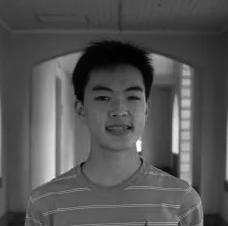
“I published an online tutorial for how to make your own charity which gives tips on how to publicize and start your own nonpro t,” San tiago said. “You need to reach out to as many people as possible to make partnerships.”
According to Santiago, his project has provided him with new experiences, and an understanding that he is making a di erence for the children of Bayamo.
“It makes me happy knowing that I am mak ing a di erence for children who really need it,” Santiago said.
Juniors Kai Micharandi and Oscar Anderson founded People Plates Planet in April of last year after seeing the rising food waste problem at Paly. One measure they implemented was to put out bins for collecting edible food around campus.
“We aim to create a greener future by conserving the water and energy used in producing otherwise wasted food while also providing nutritious meals for the community’s most vulner able members,” Anderson said.
While food waste is a leading cause of the worsening climate change crisis, Anderson said many students are unaware of its climate-related e ects. He said large amounts of energy, land and labor are allocated to producing food that is never consumed, which also creates harmful greenhouse gasses that contribute to global warming.
“When wasted food ends up in land lls, the rotting process generates methane, a greenhouse gas 30 times more potent than carbon dioxide,” Anderson said. “Yearly, 135 million tons of greenhouse gas emissions are created by American food waste.”
Since the pandemic, the food-insecurity rate has more than doubled nationally, and 33% of the Bay Area is facing hunger, Anderson said.
“We set out to recover surplus food from our school and redirect it to help those in our community with food insecurity,” Anderson said. “We began planning a system to work with campus administrators and local community partners.”
Each week, People Plates Planet donates food to the Opportunity Center which provides supportive services for homeless families and single adults.
With the miniseries “Obi-Wan Kenobi” and “Tales of the Jedi” generating the most excitement for Star Wars shows this year, to say “Andor” was overshadowed by its sister programs on Disney+ is an understatement.
Only after the disappointment of the Obi-Wan show did people realize that what Star Wars needs is not more fan service but rather a fresh plotline with strong writing and characters who have depth.
By combining the darkest tone of any Star Wars show, power ful scripts and high-caliber visual e ects, “Andor” is among the best Star Wars serial dramas of the last 15 years, deeply re ective in its themes of seemingly hopeless galactic politics and morally gray actions.
For most of the Star Wars movies, large-scale galactic-stake wars are led by someone with the Skywalker surname –– whether true Skywalkers (Episodes I through VI) or Rey (Episodes VI through IX). Meanwhile, “Andor” ips this on its head.
With no lightsaber duels or even planetary-scale ghts (so far), “Andor” draws its strength by remaining grounded in its characters and the daily lives of those living under the oppres sive Galactic Empire, masked by Emperor Palpatine’s promise of safety and order from his Declaration of a New Order. And the Empire is a force to be reckoned with in this series.
While fans may be more familiar with the equivalent of a bumbling idiot for an Empire with stormtroopers literally trip ping over themselves, unable to shoot anything from point-blank range, the Imperial forces in “Andor” radiate strength. In fact, direct confrontations never occur because the Imperial military would easily dominate their victims. e might of the Empire gives “Andor” the dark tone that allows it to stand out among its sister shows.
e presence of the Empire is enough to deter anyone from even thinking of rebelling. at is, except for Cassian Andor, the character who lends the show its title. By realizing this assump tion of uniform conformity, Andor’s tactics of stealing rely on the Empire’s overcon dence.
“You just walk in like you belong,” Andor says. “ ey’re so fat and satis ed, they can’t imagine … that someone like me would ever get inside their house, walk their oors, spit in their food, take their gear.” is con dence lands Andor a rare piece of Imperial technology worth 40,000 credits (165,000 USD), and ultimately, a path to become a leader of the Rebellion.
Additionally, rather than include overly-dramatic stakes, writer and director Tony Gilroy engages his audience with per sonal, humanizing plot points. Every character is challenged and developed in a pacing that feels natural. e show isn’t interested in making ashy, jaw-dropping changes to the existing canon. Instead, by keeping the series grounded in the daily lives of those living under the Empire, the stakes of the plot feel more personal, leading the audience to become more invested in the characters.
“Sta and residents at the center have been wholeheartedly appreciative, and the food has immediately been put to good use,” Anderson said.
People Plates Planet operates every day dur ing school hours by tracking the amount of food recovered from bins.
“As of last week, we have recovered over 1,000 pounds of food from Paly to feed the residents at the Opportunity Center,” Ander son said. “ at is equivalent to over 870 meals donated and preventing over 2,600 pounds of carbon dioxide from entering the atmosphere.”
Anderson said he hopes the nonpro t’s ef forts can in uence students to be conscious of their food waste beyond just at school.
“We see this as an opportunity to educate the Paly student body at large about the signi cance of food waste,” Anderson said. “We want to help students realize they have the power to make a di erence by simply donating their unwanted food or bringing any non-perishable food items from home for those in need.”
Senior Zach Cooper founded Friendship rough Futbol to encourage international competition and cultural exchange among soc cer players. He said his organization’s contribu tions provide opportunities for disadvantaged soccer players and clubs to compete on the world stage.
Cooper plays for a soccer team that goes on a trip to Buenos Aires, Argentina every three years.
“ is guy got kicked out of a soccer academy down there because he couldn’t pay the fees to go to the academy,” Cooper said. “So he took
over this highway underpass and created futsal courts and let anybody from the underprivileged neighborhood come play for free.”
When Cooper traveled to Buenos Aires last summer, he set up a clothes drive for the club members of Estrella de Boedo.
“I was going to start a clothes drive for uni forms and soccer cleats while collecting money from relatives and former coaches to help my teammates be able to travel,” Cooper said.
Cooper said he still sends donations directly to Buenos Aires.
e donations have provided additional soc cer and computer equipment to the soccer club. He also said that he enjoys playing with the other teams because he gets to share his passion for soccer with them.
e club needs donations not only for its soccer programs but for after-school programs as well.
“It’s more than just a soccer club,” Cooper said. “ e clubs are social clubs, so these kids will get o of school and then go to this club, where they’ll do their homework.”
According to Cooper, the idea of starting a non-pro t seemed out of his reach in the begin ning, but he learned that it’s possible.
“Having a goal or a mission for my nonpro t allowed me to stay motivated in my e orts,” Cooper said. “It is a ful lling experience and I would recommend that students explore this opportunity.”
In addition to the writing, the sets also exude a feeling of spaciousness missing in other modern “Star Wars” shows. is is thanks to the use of traditional blue/green screens and physical sets rather than the digital screens of other contemporary Star Wars series. By doing so, the places characters travel to don’t feel claustrophobic, a common side e ect of the virtual sets.
e Star Wars visual e ects teams also got to ex its creative muscles with this show. e crowning achievement of the VFX team so far has to be the depiction of e Eye, where Aldhani (the planet the protagonists are on) goes through a crystal belt and meteors burn up in the atmosphere. In the preceding epi sodes e Eye has a reputation for bringing the coldest of hearts to tears. In the sixth episode the show delivers on that promise.
e Eye is mesmerizing with its spectacular hues and sparkling vibrance, a touching moment in the general chaos of the epi sode. While technical and performative perfection makes for a pristine serial drama, “Andor” goes above and beyond by creating engaging themes of moral ambiguity and the hopelessness of altruistic actions in an indi erent society. e Empire’s retaliation through stricter legislation unmasks the façade of the dictator. Mon Mothma, a senator who secretly backs the rebellion with her paycheck, frequently ghts against the Emperor’s legislation. However, the Senate is not receptive to her speeches, with people shouting over her and even leaving the oor, illustrating the inef
fectiveness of the remaining democratic bodies of government.

e disarray of the government in “Andor” seems to echo many governments in our world. ese themes give “Andor” a avor of meaningfulness that is refreshing and rare in “Star Wars.”
With “Andor” nailing every part of what makes a great TV show, the maturity and tone of the show make it more accessible to older audiences and less to the traditional Star Wars audience.
e glimmering e ects, personal stakes and powerful underlying themes of “Andor” make the series worth watching. While the progression can feel a little slow (I would recommend watching the rst three episodes in one sitting, with a total runtime of just over two hours), the payo s within each arc, typically composed of three episodes, make it compelling. Additionally, the require ment for background Star Wars knowledge is low, even someone who has only watched the original movie will know what’s going on. Because of this, I would recommend buying a subscription to Disney+ for just a month to watch this series, because if you have the patience to watch three-episode arcs, you’ll de nitely enjoy the full extent of this masterpiece.
Monday, November 14, 2022
e Campanile B3
Lifestyle
Senior Zach Cooper prepares soccer uniform donations for his organization. “I was going to start a clothes drive for uniforms and soccer cleats while collecting money from relatives and former coaches to help my teammates be able to travel,” Cooper said.
Maarva Andor, Cassian’s mother, contemplates life under the Galactic Empire on the planet Ferrix, the main setting for the rst three episodes of the Disney+ series “Andor.” e series invests in showing daily life on its planets such as Ferrix which makes the plot more immersive.
Maarva (Fiona Shaw) in Lucas lm’s ANDOR, exclusively on Disney+. ©2022 Lucas lm Ltd. & TM. All Rights Reserved.
Gabriella Gulman Sta Writer
Erik Feng Managing Editor
ZACH COOPER/USED WITH PERMISSION
Review: ‘ e Crown’ powerfully captures narrative of Queen Elizabeth II
Net ix released the trailer for the much-anticipated fth season of “ e Crown” on Oct. 20 and an immediate restorm occurred; numerous people expressed anger and alarm at the myriad his torical inaccuracies depicted.
I can’t say I’m particularly sur prised, though. “ e Crown” has always been a ctionalized dra matization of history, and the only di erence between Season 5 and the previous four is that many real people depicted, such as John Major, are alive and able to voice their displeasure.

But regardless of historical ac curacy, the writers and producers behind “ e Crown” have created an extraordinary narrative, not only of the British Royal Family but of the entire latter half of the 20th century.
For those who haven’t heard of the international sensation that has won a jaw-dropping 129 awards, e Crown” details the history of the British royal family through the life of the late monarch Elizabeth II, starting with her wedding to Prince Phillip in 1947.
e show depicts countless trials and tribulations faced by members of the royal family throughout history, mainly focusing on three principal characters: Queen Elizabeth, Prin cess Margaret and Prince Charles.
In addition, the show heavily features the British Prime Ministers who served under Elizabeth II, most notably Winston Churchill, Harold Wilson and Margaret atcher, each of whom provides fresh commentary and perspectives on not just the royal family but British and Common wealth society as a whole.
Each individual character shines, but together they create a narrative unparalleled in complexity and nu ance. e role that each member of the Royal Family plays is cleanly and

elegantly distinguished not only with dialogue and action but also through visual features.
e Queen, representing stabil ity and authority, rarely shows any other facial expression besides a light frown. Princess Margaret shows her modernity and breaks from tradi tion with bold eyeliner and clothing with dazzling patterns, while Prince Charles, representing the new gen eration, adopts a less formal, more natural way of speaking.
e show also switches cast members every two seasons as the principal characters age, not only for historical continuity’s sake but also
to represent how the characters have changed and matured. is contrast is best shown by Claire Foy and Ol ivia Colman, who portray a younger and middle-aged Queen Elizabeth II respectively. While Foy’s depic tion shows a young woman nding her place after being suddenly thrust upon the throne, Colman portrays the Queen as a stoic, established middle-aged woman, well adjusted to the life of a monarch.
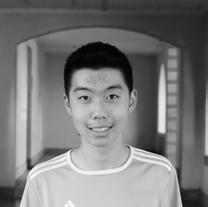
In addition to the Royal Family members, each of Queen Elizabeth II’s Prime Ministers also add their own perspective to the show. When combined, these two parts of the
show create a narrative truly unpar alleled in complexity, subtlety and intricacy.
And it is the contrast between the Queen and Britain’s rst female Prime Minister, Margaret atcher in Season 4 that is the most fascinat ing and captivating of all.
Compared with the previous Prime Ministers, atcher comes from a middle-class background, and her disagreements with the Queen are a remnant of this class distinc tion. For example, when the Queen tells atcher about how she hunted with her father for fun and subse quently asks atcher what she did
with her father as a child, atcher simply responds, “We worked,” with a perfect hint of condescension and disdainful view of the frivolity of the British upper class. is direct juxta position between the two women in their opinions sets the scene for their mutually respectful but ultimately tense relationship.
So despite not being a factual documentary, “ e Crown” master fully captures a half-century of Brit ish history. However, I’d like to note that I agree with many critics of the show that the historical inaccuracies are problematic.


For example, the Queen was reportedly “hurt” by the show’s de piction of her husband as a cold and uncaring father, particularly during a scene in Season 2 where he calls Prince Charles “bloody weak.” is potentially constitutes character as sassination. Especially considering a signi cant percent of viewers are us ing the show to learn about the Roy als, viewers should take any claim in the show with a grain of salt.
Net ix eventually gave in and Season 5 will feature disclaimers before each episode reminding the audience that the show is indeed a dramatization. I won’t have yet n ished watching the latest season by the time this review is released, but based on the trailer and clips already released, it looks to be an excellent one. So when you’ve got a free hour or two, give the series a watch. I promise you won’t regret it.
Editor’s Note: is article was written before Season 5 was released on Wednesday, Nov. 9
Monday, November 14, 2022 Lifestyle e Campanile B4
1 Ceremony and splendid display 5 Act just like 10 People who performed in 10 “Radium Girls” 14 1975 special education law 15 Petite 16 E- at saxophone 17 Symbol of plenty 19 Famous Katy Perry song 20 Regions 21 Caboose’s position 23 60 minute periods 24 Goes with gravy 28 Gar eld’s favorite dish 31 It’s Big in California 32 1932 Australian “war” 33 Owns totient function 36 Celtics Forward The Crossword PUZZLE BY CAYDEN GU AND NIDHI THUMMALAPALLI 40 Pugs and poodles 42 Started 44 Location of Galileo’s gravity 44 experiment 45 Sign into law 47 Dressed in fancy clothes 49 Shakespearean ever 50 Chair part 52 Big French dogs 54 Hosted Thanksgiving game 54 since 1934 59 Wood for English Longbow 60 Ripped 61 Metric units 65 Part of the eye 67 Type of Puritans who ed to 67 17th-century Holland 70 French port 71 Often contains the thesis 72 Small island 73 Nerd 74 What a star may stand for 74 in America 75 Halt Down 1 One-sixth of an inch 2 Scent 3 Creator of memes 4 Costa Rica neighbor 5 Canadian Master of Science 6 “If u ask me” 7 Symbol of friendly country 8 Tale of Troy 9 Necklace closings 10 Lincoln or Ford 11 Queen Liliuokalani’s song 12 Origin 13 Trunk of the body 18 Application 22 Praise 25 To rebu 26 One hundredth of a koruna 27 Mouse-catching device 28 News article intro 29 Fused with Ra 30 BTS rapper 34 Freud’s super 35 Spiritual leader 37 Wedding cake layer 38 Second-hand 39 Has the Valles Marineris 41 “The Lion King” villain 43 Burned Rome 46 Jog 48 Tribe of Sudan’s Nile basin 51 Constriction of the pupil 53 Currently 54 Faulkner’s “As I Lay _____” 55 Spooky 56 Debuted with The Story Begins 57 Counter Reformation decreed 57 in this Italian city 58 Old Greek coin 62 What Santa checks twice 63 Capital of Nordic country 64 Small for man 66 Swedish Krona 68 Hangs on walls 69 Landmark Court case 69 overturned in 2022 Across ART BY RACHEL LEE
ARTBYRACHELLEE
Lucas Guan Guest Writer
Sexualization of female athlete uniforms causes unwanted attention
Across the numerous sports at boys’ uniforms tend to include looser and longer shorts, while girls’ uniforms include form- tting short skirts or spandex. To many student athletes, one idea is clear: female athletes continue to be de ned by their sexual appeal, not their athleticism.
And many female atheletes say limited autonomy over their uniform makes them vulnerable to objectifying remarks and catcalls.
Senior Jess Watanabe, co-captain of the girls volleyball team, said her uniform, typically tight spandex, is unnecessary and uncomfort able.
“It’s really unfortunate to see that girls are getting really short and tight bottoms for no reason,” Watanabe said. “Volleyball in general has to be a little more open about what you’re allowed to wear because it doesn’t really a ect how you and other people play. What you wear is a personal opinion.”
While o cials may be reluctant to change the skirt tradition found in lacrosse and eld hockey that has existed since 1926, many sports writers have noted that the tradition is also rooted in early 20thcentury misogynist sentiment where women’s appearance in the Olympics was validated because of their allure rather than their performance.
Now, as girls uniforms have shrunk, female athletes leave the Peery Center facing the risk of being catcalled or harassed. Junior Grace Gormley, an athlete on the girls water polo team, said her team has experienced this.
“ ere de nitely have been examples that I know,” Gormley said. “(Players) have been looked at in uncomfortable ways and have been told uncomfortable things about the fact that their uniforms are (tight).”
Gormley said this unwanted attention negatively a ects the water polo team.
“(Catcalling) puts us in a very di cult posi tion because obviously we’re just wearing our uniform, and we’re just trying to play our sport, but if we’re being sexualized by our audience, that makes it a lot more uncomfortable to play in,” Gormley said.
Junior Aspen Stitt on the varsity eld hockey team agreed.
“Every female student athlete could prob ably relate to being sexualized here at Paly,” Stitt said.
Gormley also said she wishes there were more administrative support for female ath letes in this position.
“We don’t deserve to feel threatened in our space,” Gormley said. “Instead, we deserve to be supported. It’s not our problem for wear ing something that is uncomfortable. It’s the problem of those who are sexualizing us.”
Athletic Director Jennifer Crane did not re spond to emails regarding female athletes and their uniforms.
Although Gormley said she appreciates the practicality of her uniform, she said she is un comfortable in her uniform at times and feels the school should o er more options to ensure the players feel safer.
“If you’re worried about being sexualized, that will divert your focus and can put your mind somewhere else other than the game, which has a negative impact on your play ing,” Gormley said. “To play any game where you’re wearing a swimsuit, you need to be able to feel like you’re in a safe environment, and if you aren’t, that de nitely can be stressful.”
Water polo suits are de signed to be as functional as possible, according to Gormley.
ey are skin-tight and tiny, ensuring opponents can not drag the players under water. Field hockey skirts, on the other hand, lack practicality and only serve the function of upholding tradition, according to Stitt.
“I’d rather we have shorts, honestly, and I feel uncomfort able walking in the hallways with this short skirt and spandex that rides up and that I’m constantly pulling down,” Stitt said. “I’m not sure who designed the uniforms, but whoever did clearly is not a woman and did not play eld hockey, because they never would have de cided that.”
Stitt also said while she has not said any thing to anyone about her discomfort with her uniform, she said a majority of the eld hockey team would want to make the switch to wear ing shorts.
“I think most of the team would prefer shorts or something underneath that goes with (the skirt),” Stitt said. “But purchasing new uniforms would be so expensive, and (Paly) might not have the funding for that. If we did, that would be one of the top priorities, getting new uniforms with shorts.”
Watanabe, though comfortable in her out t, resonates with that statement and said she’d like to see a new design for girls volleyball shorts.
“It should be up to the player to decide what they want to wear on the bottom because
boys always have shorts that go down to their thighs, and they don’t really have to expose anything that they don’t want other people to see,” Watanabe said. “But then with volleyball, when you’re playing, you could have your span dex all the way up your butt and you just don’t want that. I don’t really understand why it has to be super tight.”
Stitt said o cials and school administrators should do more to reduce sexualization and improve players’ potential and well-being.
“(Sexualization in) sports is present in high schools and we all have some sort of uncom fortable situation with the skirts or shorts or wearing anything,” Stitt said. “So the uniforms are de nitely something to ( x) because obvi ously, you don’t see this on (boys) teams.”

Following a critical 40-22 victory against Milpitas, the varsity football team has quali ed for CCS Division V league playo s.
Senior and running back Jack New man said the team started the game o slowly, and head coach David DeGeronimo credits the win to the team’s perseverance.
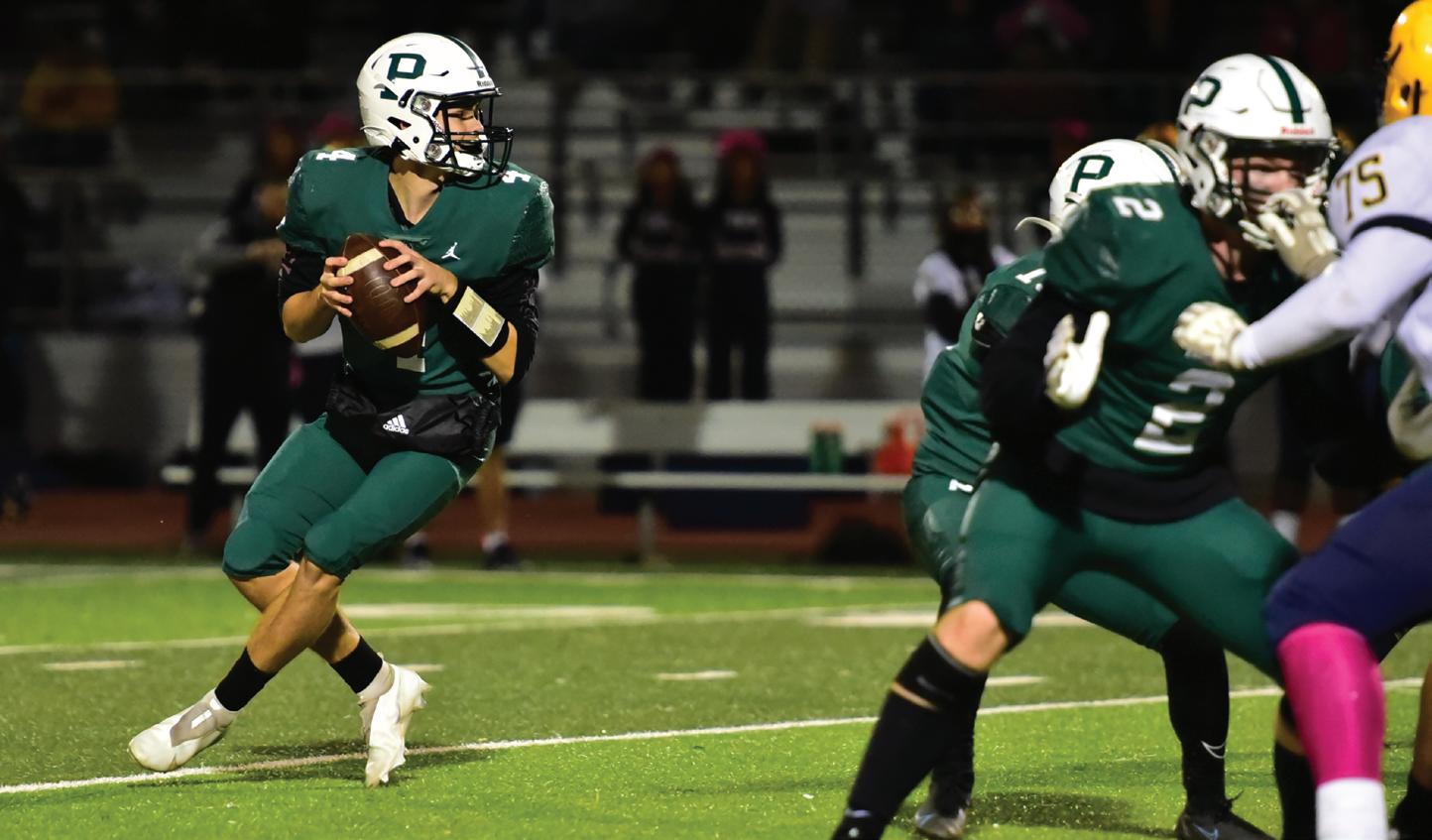
“We were up and down all night,” De Geronimo said. “But these guys refused to quit, and they played their butts o .”
Senior captain and lineman Vainga Mahe said that although the season had a rocky start, the team was able to recover from it.
“We started o really rough, and now we’re in the playo s,” Mahe said.
DeGeronimo said the team’s mindset for playo s is to keep playing and focus on staying in contention.
“My hopes for the playo s are just to see who lines up against us and to play one more week,” DeGeronimo said.
Mahe said as the team heads into its last few games, he continues to push himself despite the uncertainty.
“It’s very exciting, but very sad be cause I know these are my last couple of games,” Mahe said. “I don’t really know when it’s going to end, but that’s why I play 100% every play.”
After a disappointing playo exit last season, varsity boys bas ketball coach Je LaMere said he has his sights set on winning the CCS nals.

While LaMere strives for a successful season, he said improvement, both as an inde pendent and team player, are of utmost importance.
“Certainly our goal is to try to win the championship,” LaMere said. “We always want to be really good in our league, but we need to have our sights on improvement.”
After a challenging season last year due to COVID-19, LaMere said he hopes his players will understand that sometimes unfortunate things happen that are outside of their control.
However, LaMere said he wants them to focus on what is within their control.
“We always emphasize the things you can control,” LaMere said. “We’re focusing on every play. Are you getting on the oor for a loose ball? Are you block ing out shots going up? Do you box out?”
LaMere said consistent indi vidual e ort will determine the team’s success this year.
He also said he values a posi tive team dynamic where each player supports their teammates.
“We have something (called) EGBs or energy giving behav iors,” LaMere said. “If you see
Sports e Campanile Monday, November 14, 2022
Junior quarterback Declan Packer drops back for a pass against Milpitas on Oct. 28. About the team’s 40-22 victory, coach David DeGeronimo said, “We were up and down all night. But these guys refused to quit, and they played their butts o .”
DHRUV SHETTY/THE CAMPANILE
somebody a little bit down, pat them on the back and say, ‘Hey, let’s go man. Let’s get this next play.’ We want them to have a next play mentality.”
Before the season kicks o on Nov. 26 against Paci c Grove, LaMere said he hopes to push each player to continuously im prove and work towards becom ing their best.
“What I want to try to com municate to the players is that you can’t look at where you’re at right now,” LaMere said. “You start with a thought of, ‘How can I get better each day?’”
Junior Tyler Frick looks for an open pass as junior Tyler Wong guards him during the boys varsity basketball tryouts.
“Certainly
our goal is to try to win the championship,” LaMere said.
LUCA VOSTREJS/THE CAMPANILE
ART BY RACHEL LEE
Dhruv Shetty Sta Writer
Luca Vostrejs Guest Writer
Nidhi ummalapalli Sta Writer
Dancers defend sport despite lack of recognition for college recruitment
As sophomore ballet danc er Cate Graney glides across the Marley oor, all she can think about is ballet: she nally escaped from the stress of her everyday life. For dancers like Graney, a technique-focused sport such as dance can serve as a distrac tion from the worries she experi ences outside of the studio.
However, unlike many ath letes, most dancers are not o ered commitment o ers from colleges in America. Instead, many con tinue their dance careers through audition-based college dance teams and programs with their own initiative. Nevertheless, like many recognized sports, dance serves as an outlet for creativity and expression for dancers of all genres.
ARTBY KATIEXIA
For senior and dance team captain eresa Hart, dance is an outlet for self-expression that requires consistent commitment. Hart also said she dances because it’s a source of happiness for her.
“For me, it’s great exercise and a way to express myself,” Hart said. “I also really like dance because I’ve done it my whole life.”
Dance also provides Hart a fun intersection between artistry and athleticism.
“It’s really beautiful to watch and so fun to learn and experiment with,” Hart said. “It’s like doing art and a sport all in one.”
For some like senior hip-hop dancer Zachary Scott, dancing can also be fun because of its welcoming community.
“At our studio, we really work to make sure that everyone feels accepted,” Scott said. “When I am dancing, I feel that there is no judg ment, so I can truly be myself.”
As a former musician, Scott also said dance is an amazing way to con nect with the rhythm of the music.
“After I stopped (playing piano and violin), I still felt a really strong connection to music, and so I de cided to start dancing,” Scott said. “Dance gives me a way to connect with the music, and it feels natural to me.”
And Scott said he is committed to dancing for years to come.
“I haven’t decided whether or not it is something I want to pursue as a career, but I will de nitely keep dancing whether that be a dance team or taking classes for fun,” Scott said.
Although dancers sacri ce end less time and e ort, Hart said many remain unsure of their futures in dance.
Hart said her future will depend on the college she ends up attending.
“If the college I end up in has a dance team that I think I could pos sibly get on, I will audition for the team or maybe try a club,” Hart said. “I would not actually major in it.”
However, dancers’ inability to be considered for college recruitment is something that Hart said is rooted in how people view dance.
“I think it comes from dance not being considered a sport,” Hart said. “Some schools have amazing dance programs, like the University of Minnesota or Ohio State, and danc
ers should be able to be recruited for a sport that they win competitions in.”
Graney said that she is disap pointed that colleges don’t recognize dance as a sport, and she hopes that in the future, colleges will acknowl edge the lifelong commitment and many sacri ces that dancers put into their craft.
“I think it’s such a bummer because people commit to dance for their whole life, and because of that, they don’t have any time for other sports that they may have wanted to do,” Graney said. “I think colleges should recognize their commitment.”
Consequently, the future for many dancers is often not as rooted in competition and joining college teams as more conventional sports tend to be.
“I de nitely want to continue dancing but just for fun,” Graney said. “I don’t really know what I’ll do with dance in the future, but it depends on where I go.”

Hart said that even though she is disappointed by dance program’s relationship with college acceptanc es, she has come to terms with the fact that her competitive dancing is unlikely to continue.
“It’s kind of sad that my dancing won’t go anywhere in the long run,” Hart said. “Personally, that’s just a choice I’m making, and it’s some thing I’ve come to terms with.”
Shiki Toyama Business Manager
Gavin Lin Guest Writer
Finishing with an 11-13 record and a 3-6 league record, the girls water polo team clinched the No. 2 seed in the CCS Division I tournament, where they faced Branham High School (4-6) on Nov. 5 at Los Altos High School.
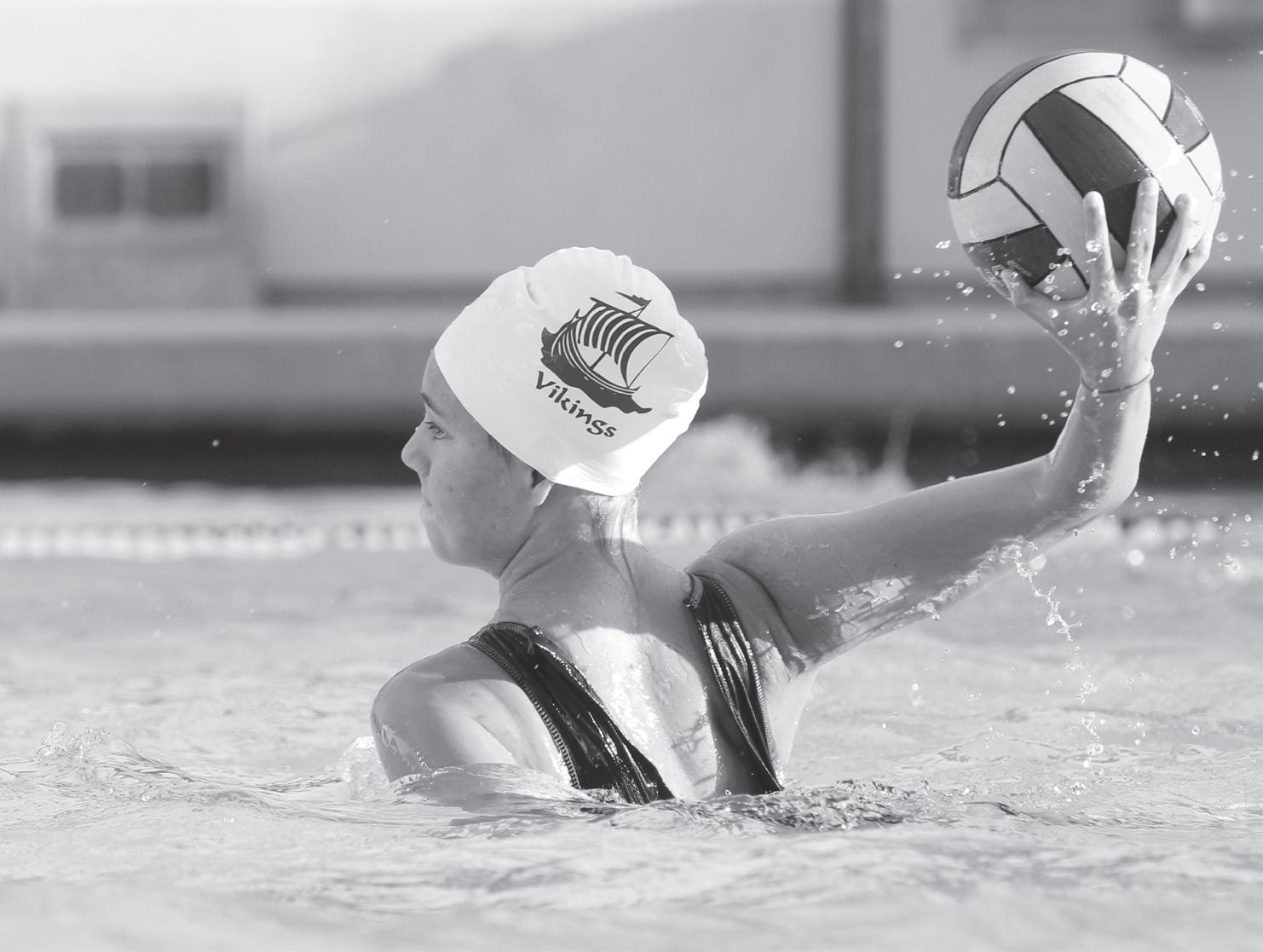
Senior and team captain Sami Lee said their strong defense was an important factor in qualifying for CCS.
“We have the best defense in the league, meaning we keep teams to the least amount of goals scored on average (com pared to) any other team,” Lee said.
Despite a strong defense, the team has still faced a number of problems. Lee said the team struggles with acclimating to the large in ux of underclassmen.
“I’d say our biggest challenge has been age range,” Lee said. “It’s three sophomores and ve freshmen. I’d say having all those new girls on var sity contributing has been amazing and great, but
it’s a struggle because there’s so many young players not new to this sport but new to this program.”
Junior and co-captain Eliza Gaither agrees that the new underclassmen have changed the team chemistry.
“I think our biggest challenge has probably just been getting down a new team connection because we added a lot of underclassmen this year, and we haven’t been used to playing with each other,” Gaither said.
Katie Bradley, a sophomore who moved up from the JV team, said the team has also experienced trouble with com munication during games.
“We had some communica tion issues which caused some problems, but overall we didn’t have many problems,” Bradley said. “Something we could work on next year is communicating more.”
Despite the problems the team has faced, Lee is excited about qualifying for CCS.
“I’m super excited about going to CCS,” Lee said. “I think we always kind of look toward CCS. It’s always been the end goal.”
Shamsheer Singh Sta Writer
After facing increased competi tion in the upper De Anza division of the Santa Clara Valley Athletic League, the girls varsity eld hockey team concluded the season with a 1-11-2 record. Despite the record and a close 0-1 loss during a re match against Saint Francis on Oct. 27, senior Mia Rose Tuifua said the team has shown major improvement.
“Our team was so hyped to play them again,” Tuifua said. “I was re ally proud of our team, defensively and o ensively.”
Coach Jennifer Crane said the game re ected the team’s hard work throughout the season.
“It was a great way to close out the season,” Crane said. “Our team had good spacing on the eld, was rst to the ball and translated skills and concepts we’ve been working on this season onto the eld.”
Re ecting on the season, Tuifua said she is proud of her team for stepping up as it entered a higher division this year.
“We played very hard teams,” Tuifua said. “Some of the teams we played were expected to com pletely blow us out, but we stood our ground and held up with a lot of them.”
Senior and co-captain Anna Wingard said she is grateful for the season and the close relationships she built with the members on her team.
“I’m really happy with how this season ended, and I know we gave it our all,” Wingard said. “I have been playing with Ms. Crane and most of the girls for multiple years, so we as a team have a relationship which al lows us to give each other construc tive criticism on the eld, as well as having fun with each other.”
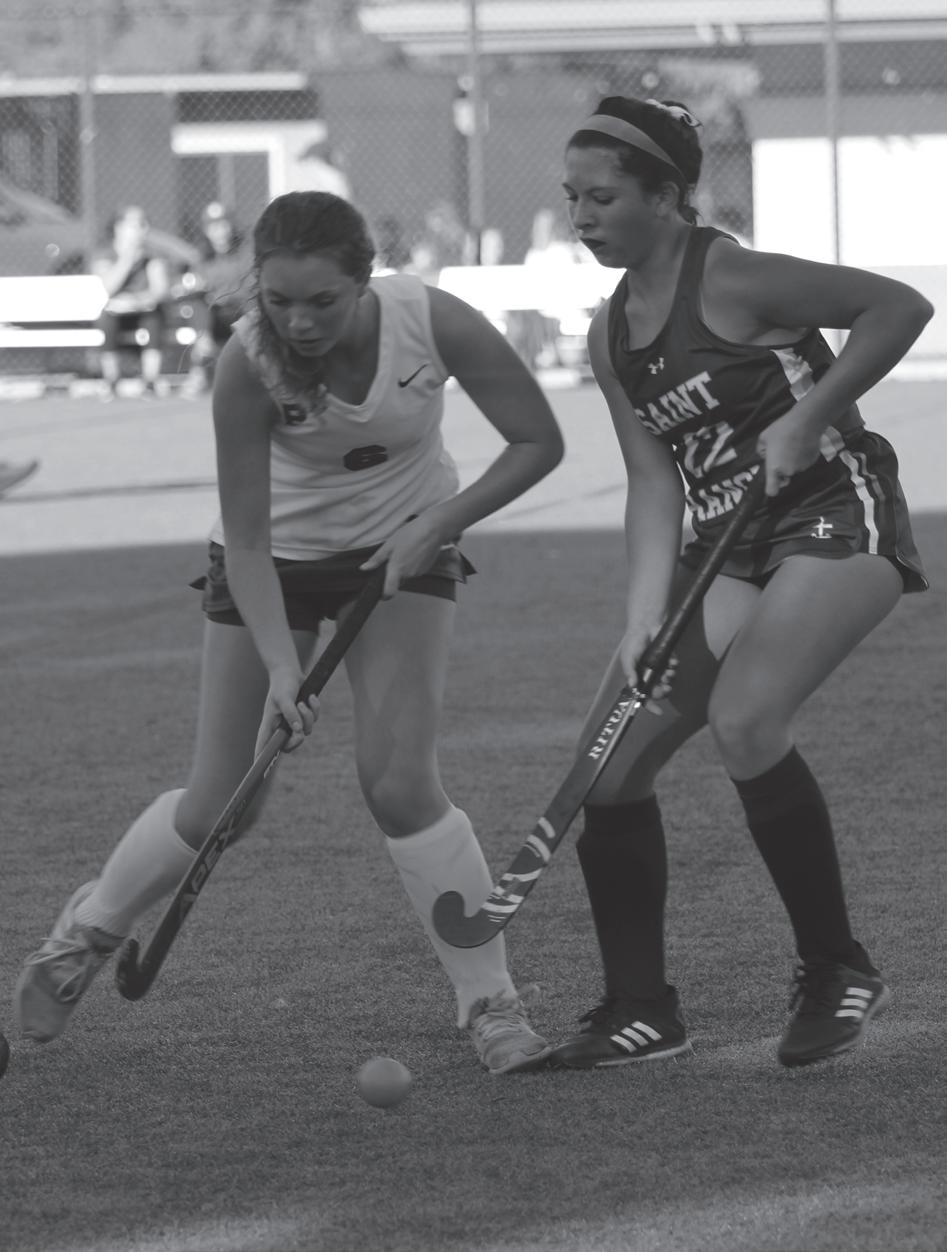
As a senior, Tuifua agreed that this season was a great way to nish out her high school eld hockey career.
“I would not have wanted to play with any other team,” Tuifua said. “ e girls I played with were more than my teammates; they were my friends, and even though our record shows a rough season, my teammates made it the best.”
As boys water polo ends the season 20-6, senior and co-captain Will Rowell said the team’s performance this season has been better than expected.
“We didn’t really know what to expect going into it, but we’ve been playing well and winning games,” Rowell said.
Julien Chow, also a senior and a co-captain, agreed and cited the team’s second league championship in a row as proof.
“ e juniors really stepped up this year when we needed them to,” Chow said.
Chow said the team has moved up to a more com petitive league.
“Because (we won league championships), we have been moved up to Open Division for CCS, which is (considered the) private school league,” Chow said.
Overall, Rowell said the season has been a success. He also said the team is reaping the bene ts of hard work.
“Our team dynamic is really good — we all enjoy being around each other and are all good buddies out side of the pool,” Rowell said. “But, we know when to start taking things more seriously and can really focus when we need to.”
Lillian Clark Lifestyle, Sci/Tech Editor
Monday, November 14, 2022 Sports e Campanile C2
Anna ieman throws the ball in a game against Branham High School. “We have the best defense in the league, meaning we keep teams to the least amount of goals scored on average (compared to) any other team,” Lee said.
GAVIN LIN/THE CAMPANILE
BRIANNA ZHOU/THE CAMPANILE
Aspen Stitt dribbles the ball away from a Saint Francis player on the El Camino eld on Oct. 4. “I was really proud of our team, defensively and o ensively,” Mia Rose Tuifua said.
Student athletes give insight into college recruitment process
Lillian Clark Lifestyle, Sci & Tech Editor
Hillary Studdert, a 2023 Stanford University track and eld commit, will soon sign onto the team o cially.
After over a year of back-and-forth emails and social media communication, Studdert will soon become a part of the 2027 Stanford graduating class.
Everyone’s journey to post-secondary educa tion can be stressful, and the process is di erent for student athletes compared to non-athletes.

From athletics to academics, many students recognize that the college recruitment process is both a business and a huge decision.
“Sometimes, it feels like coaches forget they are talking to a 17-year-old making a huge decision,” Studdert said. “Neither party, the coaches (nor) the recruits, want to get left with nothing at the end of the process, so it can get tense at times.”
is process is known to be complicated, and there are college counselors who focus on guid ing students through their recruitment.
Katie Anderson is a college counselor for student-athletes who hopes to continue playing in college, and she said the recruitment process begins with a student-led discussion with their families.
“I recommend that student-athletes start asking the questions or at least having con versations with their families at least midway through their sophomore year,” Anderson said.
Because of the NCAA division rules for contact, timing is key in the process.
“Coaches can start talking to their pro spective recruits on June 15, between their sophomore and junior year … and that’s not all sports, but that’s most sports,” Anderson said. “So that’s why you want to start having a conversation with your parents and college counselor in that second semester of your sophomore year.”
Studdert said she began the recruitment process by contacting coaches.
“I began my recruiting process late in the summer of sophomore year and beginning of junior year by reaching out to schools and get ting in contact with coaches,” Studdert said.“I sent emails to a lot of schools I was interested in and from there set up initial phone calls and meetings with coaches.”
Senior Julian Galindo, a 2023 golf commit at Middlebury College, said he started the process in the same way Studdert did.
“I started my recruiting process at the end of my sophomore summer,” Galindo said. “I reached out to all the coaches of schools I was interested in attending via email.”
And while emails are important in the process, so is social media according to Anderson. Student-athlete social media accounts dedicated to their sport can be a pivotal way of catching the attention of coaches at any time outside of o cial NCAA division regulations, Anderson said.
“I highly encourage kids to utilize social media because social media is something that
ART BY KATIE WU
you can start whenever you want,” Anderson said. “You can follow schools and their ath letic programs whenever you want, and those coaches, if they’re interested, can follow you back whenever they want.”
While the athletic recruiting process may di er from the traditional college application process, a common thread among both is nding a place that ts the student in all aspects including academics, nances and personality.
“It’s a lot about athletics, but it’s also an academic question and a nancial question … so it’s really important that the conversation is an honest conversation,” Anderson said.
As the process continues and a coach wants a student on their team, they will do a pre-read where they ask the student to send their transcripts, test scores and senior year classes. is is a process all potential college athletes must go through, Anderson said.
“ ey will walk that information into their admissions department, and there’s usually a liaison in the inner department who deals with athletes, and they will have that liaison look at the student-athlete pro le,” she said.
While the college process is di erent for athletes than for those going to college via the traditional route, it can still be stressful.
“I am super grateful for the opportunities the recruitment process has given me, but there are de nitely parts of it that are awed and di cult to navigate,” Studdert said. “It is sort of a business, which can be di cult to navigate as an athlete without proper support and advice.”
Despite multiple injuries to key play ers, the girls varsity volleyball team, 3-9, looks to make it as far as they can in the playo s, coach Chris Crader said.
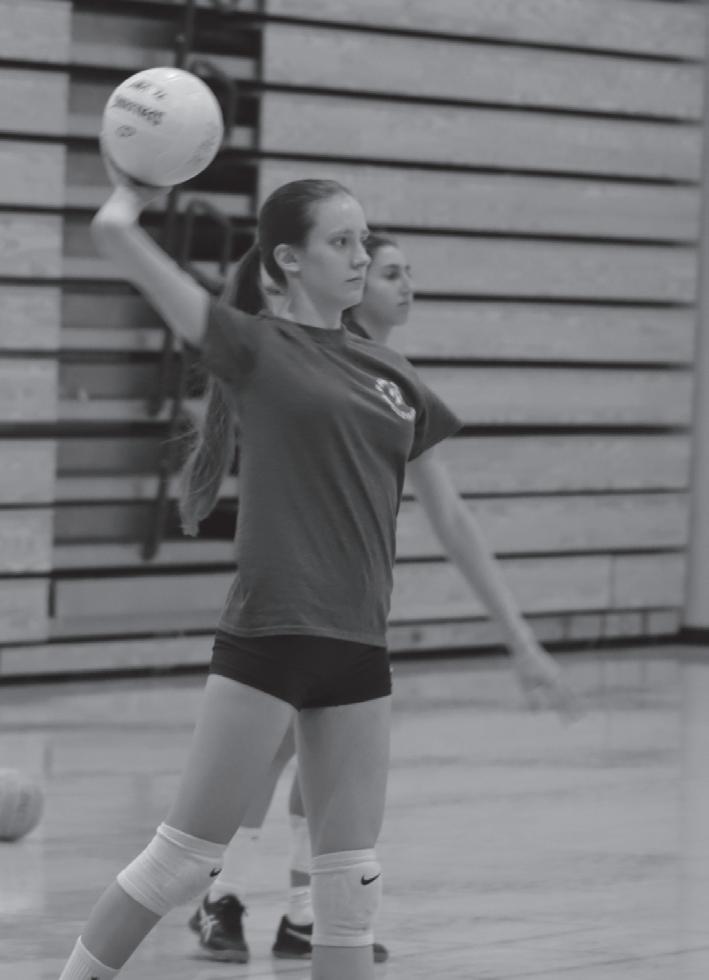
Crader said he was particularly proud of the way his team performed in its recent comeback victory against Monta Vista.
“After having those rough experiences and con dence not being high, to be able to come back like that shows a lot of character and a lot of class,” he said. “I’m glad for everybody that we won.”
Co-captain Jess Watanabe, who was out for the Monta Vista game due to injury, said being unable to play and help the team was di cult.
“I think the biggest challenge for me is my mentality and staying positive when I mess up because I was out for a little while,” Watanabe said.“I’m not back to 100% yet. And so I think just realizing that it takes a lot of time for me to get to where I was before, has been pretty di cult.”
To overcome injuries such as Wata nabe’s, Crader said the team is practicing more and hopes to advance to playo s.
“If we can win, then we earned the right to have one more practice and play one more match after that and hopefully we can repeat and repeat and repeat,” Crader said. “I think we’ve gotten back to a good place, and we’re playing well.”
Watanabe said she is motivated to keep working hard to help the team get as far as it can.
Watanabe said, “If we end up going down, then I hope we go down with a ght.”
e girls tennis team placed fth in the league, but is hopeful to win the championship.

Senior and captain Riya De Datta said the team has improved socially throughout the season de spite the tough competition.
“Overall, we have had a really competitive season,” De Datta said. “As a team, we have created a really strong bond that has made the season special”
And while many members believed the team has improved, head coach Andy Harader said he was not satis ed with the recent losses to Mountain View and Los Altos.
“Earlier in the season we were going ne,” Harader said. “But as of late, there were too many distrac tions.”
Harader said it was challenging to ensure enough dedication from the players throughout the season. Extracurricular interests drew time from practices, a ecting the team’s performance.
Despite these obstacles, junior Carlin Lee said she enjoyed working with friends in a community of likeminded people.
“I don’t see unexpected problems, it’s just the constant challenge of improving your game and nding the motivation to do so,” Lee said.
Lee also said the team was impacted by the departure of a group of talented players who graduated last year.
“We lost six seniors, so we did have a smaller team that wasn’t as quite polished as usual, so I don’t think we did as best we could,” Lee said. “But that’s to be expected.”
Additionally, Lee said the team is struggling be cause it is playing against stronger and more com petitive schools in the De Anza division.
“We were much better last year, but suddenly moving up to compete against the best of the bests was hard,” Lee said.
For
and
“Six girls will compete in SCVALS, with two singles players and two doubles teams,” Harader said. “We might see the team reach CCS next, not contingent on SCVAL outcomes but based on the strength of our league.”
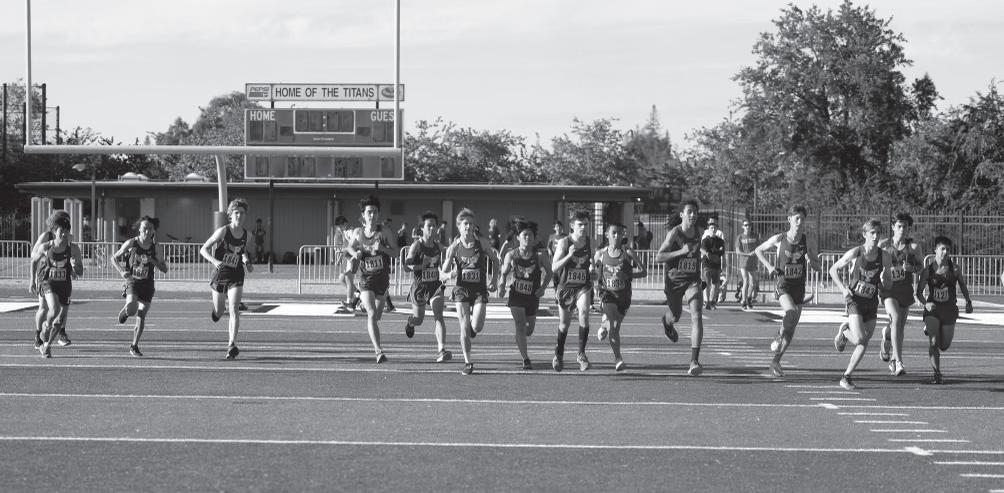
Runners who quali ed for CCS championships are still training for the meet, which will take place on Nov. 26. And despite several injuries on the boys varsity team, senior and co-captain Kyle Park said the team still hopes to compete well during the meet while fostering a stronger sense of community.
Park said even though competitive success is important to the team, he wants to help create an exciting, motivational and inclusive culture, which can be di cult to achieve in such a grueling sport.
“A long-term success for the team, in my opinion, would be a (community) that supports that notion of inclusivity in which nobody is left behind and everybody has somebody who supports them,” Park said.
Park also said having a strong support system can help during rac es, especially for high-stake meets in which runners feel pressured to compete well.
“It’s really easy to give into your nerves and lose focus, but we usually do a chant right before our races to help ease this feeling,” Park said. “I think experiencing that spirit in such nerve-wracking situations really helped us bond, both as teammates and friends.”
Senior Brooke relkeld said she values the team’s strong community, which has grown consistently over the course of the season, especially because the upperclassmen and underclassmen bridged the divide.
“Everyone on the team is so supportive and caring, which created a sense of community even from the start,” relkeld said. “ at’s one of the reasons why this season has been my favorite out of all my past years on the team, and I’ll miss all of the team bonding events like pasta feeds and group races.”
Sports e Campanile Monday, November 14, 2022 C3
CAYDEN GU/THE CAMPANILE
KYLE PARK/USED WITH PERMISSION
e cross country team begins the Palo Alto City Championship at the Gunn football eld on Oct. 26. “Everyone on the team is so supportive and caring, which created a sense of community even from the start,” senior Brook relkeld said.
Senior Lauren Wong and sophomore Kelly Tanaka celebrate after winning a point against Leigh High School of San Jose during the rst round of CCS team champi onships on Nov. 9.
SCVAL
CCS, Harader said he plans to send members to compete in the away games. However, he said the team’s success will depend on its preparedness and the results of the rst few matches.
Rachel Lee Art Director
Albert Jung Sta Writer
Lifestyle, Sci & Tech Editor
Christie Hong
RACHEL LEE/THE CAMPANILE Senior Taylor Zeman prepares to hit a serve during practice. “I think we’ve gotten back to a good place, and we’re playing well,” coach Chris Crader said.
TikTok becomes new search engine
When TikTok launched in 2016, many teenagers viewed it as just another social media platform for dance videos and pop music. However, after global popularity in 2020, TikTok is now known for being a creative outlet as well as an increasingly accessible search engine for Generation Z.
According to a Pew Research Center study, nearly 40% of Generation Z prefer researching topics on TikTok over platforms such as Google.
Senior Katie Firtch said she thinks Generation Z uses TikTok as a research tool due to its convenience and speed that appeals to their short attention spans.
“I would say that because of our very internetattuned upbringings and our reliance on very easily consumable media and information, the TikTok format appeals to Gen Z because it doesn’t require a lot of attention,” Firtch said. “Using TikTok is a fast way to get a lot of information on a lot of topics.”
Freshman Ella Oliger said when searching on TikTok, many kinds of responses show up from di erent people who have di erent opinions, which appeals to her in multiple ways.
“When you look something up on Google, you get very precise search results in articles, and some times your question isn’t really answered,” Oliger said. “When you look things up on TikTok, you’re listening to real people and you can pick and choose what you want to listen to.”
Junior Alma Samet said she looks to Google for news and to TikTok for lifestyle choices and aesthetics.
“I would rather learn from a cred ible news source instead of a random person,” Samet said. “But when it comes to more aesthetic things in my life, like where I want to eat or where to buy clothes, I prefer to search on TikTok.”
Firtch said in addition to lifestyle choices, TikTok is a platform used to inform people about news.
“I nd that a lot of people on TikTok tend to use it as a source to disseminate information about political movements and political activism,” Firtch said. “(Content creators) forecast if they believe people win certain elections for a reason, or they might say, this
Jung Sta Writer
Developments in arti cial intelligence have de ned a new eld of digital creativity, expanding what is o cially classi ed as art. However, this technological advancement has raised concerns about the legality and morality of AI-generated works.
According to the Computer History Museum in Mountain View, AI art was rst introduced in the 1960s when researchers built autonomous robots that trained machines to generate visuals. Now using models that mimic human intelligence, AI can create unique visuals with the press of a button.
AI art generators exist across the internet, giv ing rise to successful companies such as NightCafe, DALL-E-2, Artbreeder and Midjourney. Yet Com puter Science Principles teacher Matthew Rossilion said there are many potential legal concerns that come with using digital art generators.
“I generally see AI art in con ict with copyright laws and areas of fair use,” Rossilion said. “ e general four factors (of fair use) we look at, we should take that into account.”
Fair use, which is the use of any copyrighted mate rial done for a limited and speci c purpose, can be generalized as a defense against copyright infringe ments. Rossillon said fair use focuses on the purpose and character of its use, the nature of the copyrighted work, how much is used in relation to signi cance and
candidate is a good or bad person to ll a Senate position, in the house, or as a governor.”
Also, Samet said TikTok is a useful search engine due to its interactive nature. She said among the main social media platforms, TikTok is the best at connecting viewers and creators.
“TikTok is interactive because you can always ask questions in the comments,” Samet said. “ en, a creator
might make another video answering your question. You can get follow-up information if you want to from the same person, which is cool.”
However, Firtch said TikTok can feed its inexperi enced users, who also tend to be younger, more misin formation than traditional search engines. Firtch said she recommends students research topics on trustworthy platforms other than TikTok.
ART BY IVY LEE
e biggest fault with TikTok and the spread of misinformation is usually the fact that people like to make statements about many di erent individual problems and loot them all under the same umbrella,” Firtch said. “ at makes produc tive discourse about (information given on Tik cult because people don’t know where to
Firtch also said information on TikTok is often ltrated by personal opinions and biases.
“On Google, it’s easier to nd deliber ately reliable information on .edu sites or .gov sites,” Firtch said. “Whereas on Tik Tok, there’s no way to see which accounts are government associated or university liated versus who’s just saying things as they can.”
In order to fact check infor mation on TikTok, Firtch said she does her own research using more attested sources.
“I try to check accuracy by looking up other TikToks, look ing at other posts on social media or looking at other sites on Google that corroborate the information or debunk it,” Firtch said.
While TikTok can spread mis information, Firtch said it can be a creative outlet to spread knowl edge.
“TikTok is a gamble and a free for all,” Firtch said. “But it can be a good outlet for seeing what people think, even if the information may be a little biased.”
 Hannah Singer News/Opinion Editor
Hannah Singer News/Opinion Editor
“I wonder what exact algorithms it goes through (and) see how it selects stu and how much of this inspiration it takes from somebody,” Rossilion said. “A lot of art, in general, gets inspiration from somewhere or someone else, but (it’s strange) when it comes to arti cial intelligence taking and learning from a real person’s work.”
In the U.S., images created from text prompts are not protected under copyright. So, though AI art does not break any laws, art teacher Tracey Atkinson said the uncanny ability to mimic human art opens up new and concerning possibilities for arti cial intelligence.
“I’ve seen artists nd their artwork online, except that it wasn’t really made by them, but copied styles from computers being bought by people,” Atkinson said. “It looks like the styles of artists, but it’s not by that artist, and that’s very disturbing.”
Atkinson said she views AI art as an unfair, eerie cheat system that provides more harm than bene t.
“In any profession in any eld, if somebody steals the skill that you have spent years creating, that’s disturbing,” Atkinson said. “I have not seen enough bene ts, other than (that art) can seem more a ordable for the masses from the work of a computer.”
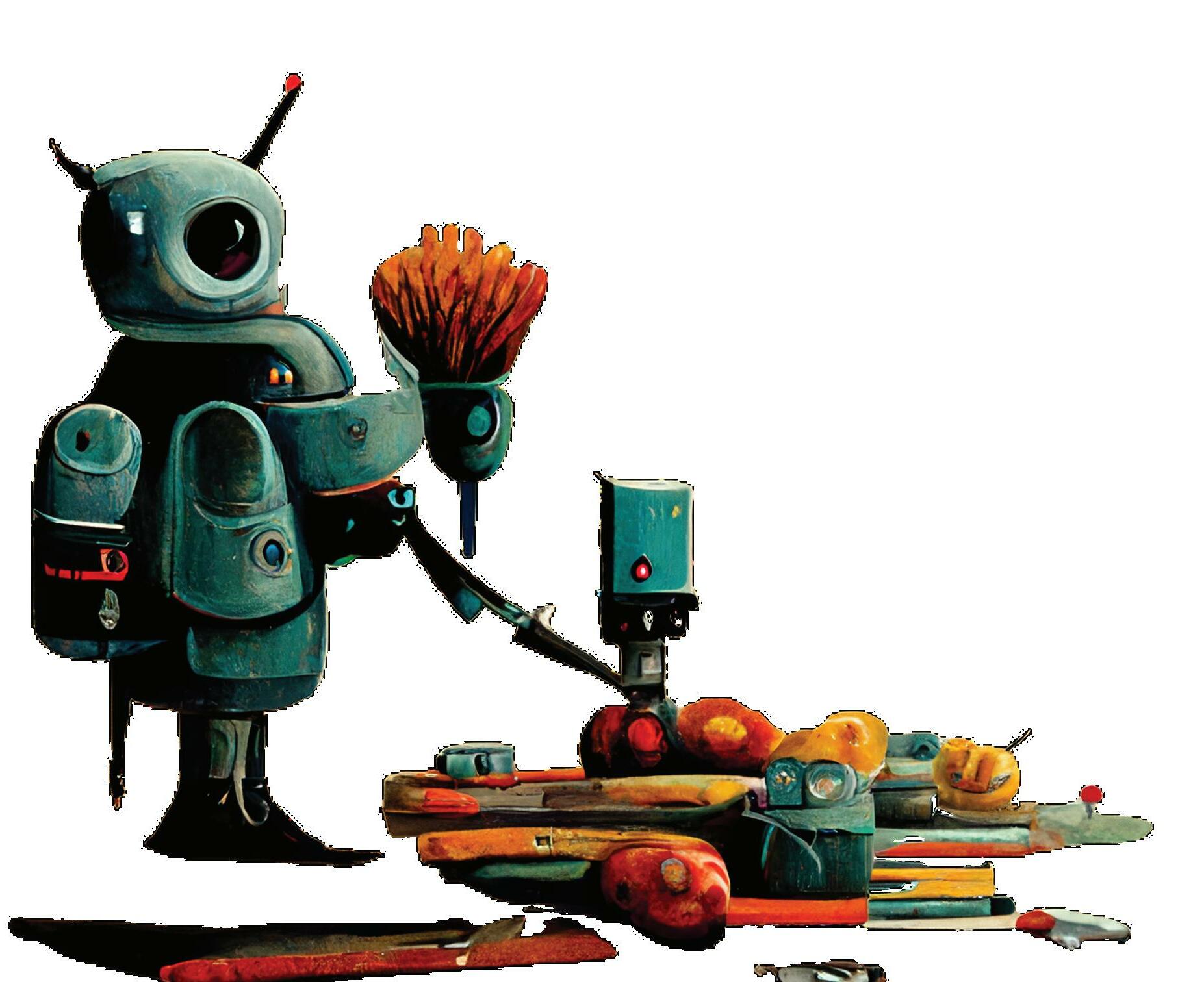
Atkinson also said that while AI assisted generators are appealing because of their accessibility, they detract from the purpose of art.
“(AI generators) are fast and easy in an attractive way. But when you look closer, the humanity is gone out of that,” Atkinson said. “Art is one way that people still keep their humanity. If computers are imitating
artwork in question since AI isn’t starting with a blank really entirely original in my eyes, so it almost feels like
like AI-generated short stories. Sure, the words end, there’s no meaning in it, which is why the
Students all around the class take out their computers as their teacher pulls up the slides for the day. e cacophony of clicking keys is constant as the teacher lectures in front of the class, showing that the way students take notes has shifted to a more technology-based approach since the pandemic. at trend looks to be continuing even post-pandemic. ough this shift towards technology was necessary during the height of CO VID-19 school closures, junior Malia Alvarado said many of her peers have con tinued to discard notebooks in favor of technology for note-taking.
“I’ve noticed that many stu dents have shifted their note-taking methods to digital, whether that is using a laptop or a touchscreen device that mimics writing,” Alvarado said.
Alvarado said that while she thinks technology can improve col laboration and research-based learn ing, typing notes on a laptop is less helpful for her own note-taking.
“Note-taking on paper allows me to process and absorb information e ectively,” Alvarado said. “When I type notes on my laptop, I focus more on typing than processing information.”
While Alvarado said she thinks taking notes on paper increases her information retention, senior An thony Chiu said he uses his laptop to keep up with teachers’ lectures.
“Occasionally, I use my computer because my hand gets tired, and it becomes hard to keep up with what the teacher’s saying, especially because my handwriting’s not that great,” Chiu said.
However, Chiu said the downside of using a laptop for notes is the ease of distractions.
“Computers are so versatile and can be used for other things besides note-taking,” Chiu said. “It’s so easy to switch to doing something else or click on a noti cation and get distracted.”
AP Psychology teacher Chris topher Farina said while research shows taking notes by hand is more e ective, it’s not the physical act of writing that makes the di erence. Instead, it’s the content the student takes notes on.
“When peo ple take notes on computers, they can type faster than they can write with their hands, so they try to type every single thing that they hear or read on the screen,” Farina said. “Whereas when people are forced to write by hand, they can’t possibly keep up with all of that. So they have to be paying really close attention and evaluating what in formation is actually worth putting down.”
Farina said this form of evaluating information is what allows for strong note-taking. He said both handwrit ten or typed notes are valuable, as long as students continue interacting with the content.
“ e biggest di erence for anybody that wants to take notes on their computer is making sure they’re not trying to copy every single thing down,” Farina said. “If you’re able to do the same (interaction with content) by typing, that may confer every bit as much of an advantage as handwriting notes.”
Gabriella Gulman & Dinu Deshpande Sta Writer
Science
e Campanile Monday, November 14, 2022
& Tech
& Sports
Editor
Albert
MADE WITH MIDJOURNEY.COM/CCNC 4.0




















 Brianna Zhou Sports Editor
Brianna Zhou Sports Editor












 Sta Writer
Sta Writer






















 Hannah Singer News/Opinion Editor
Hannah Singer News/Opinion Editor
